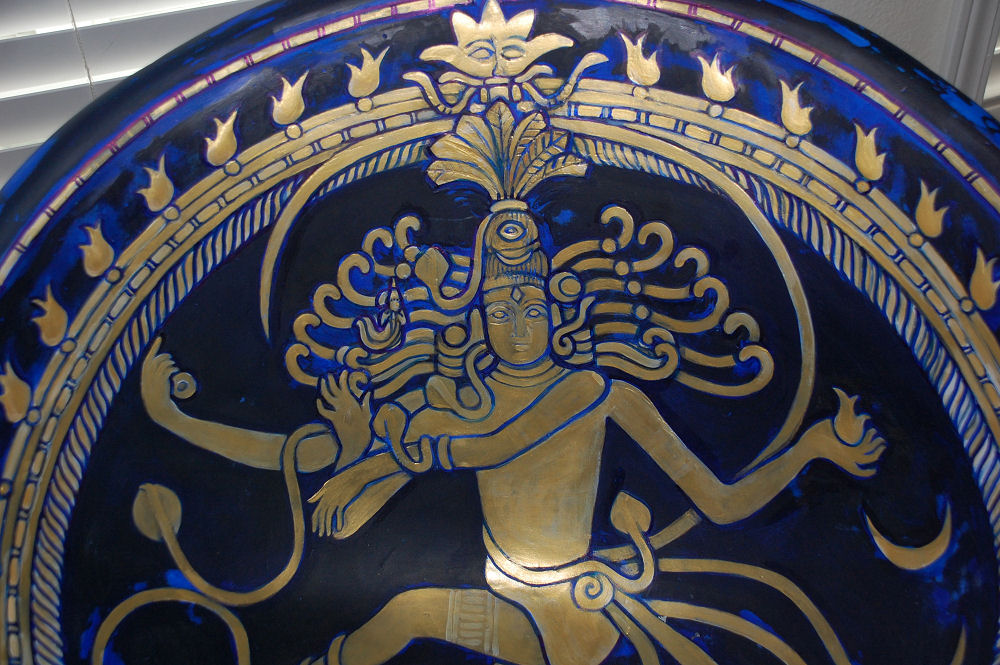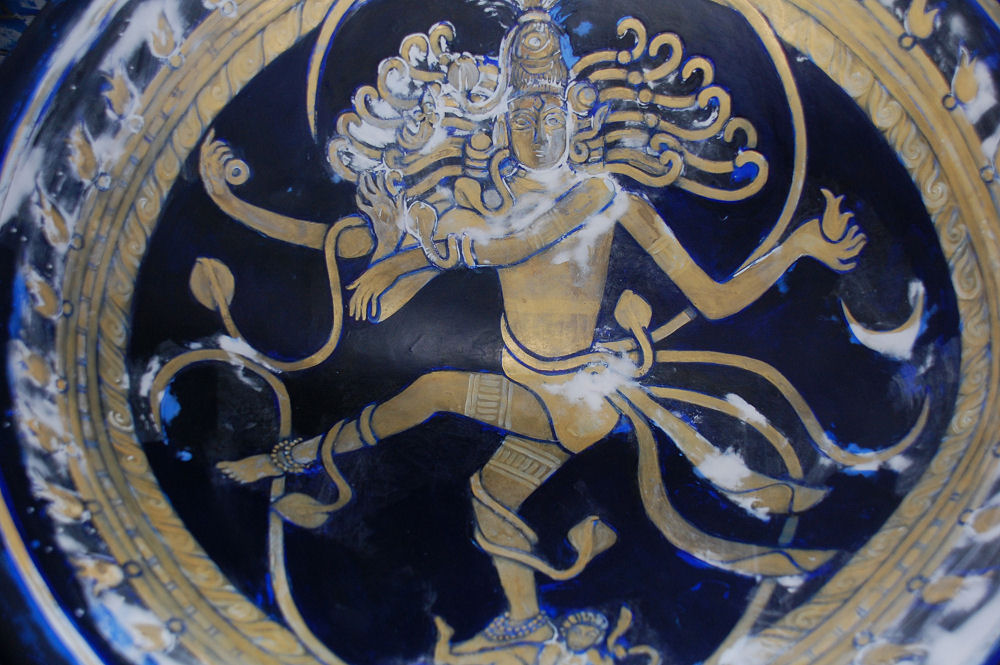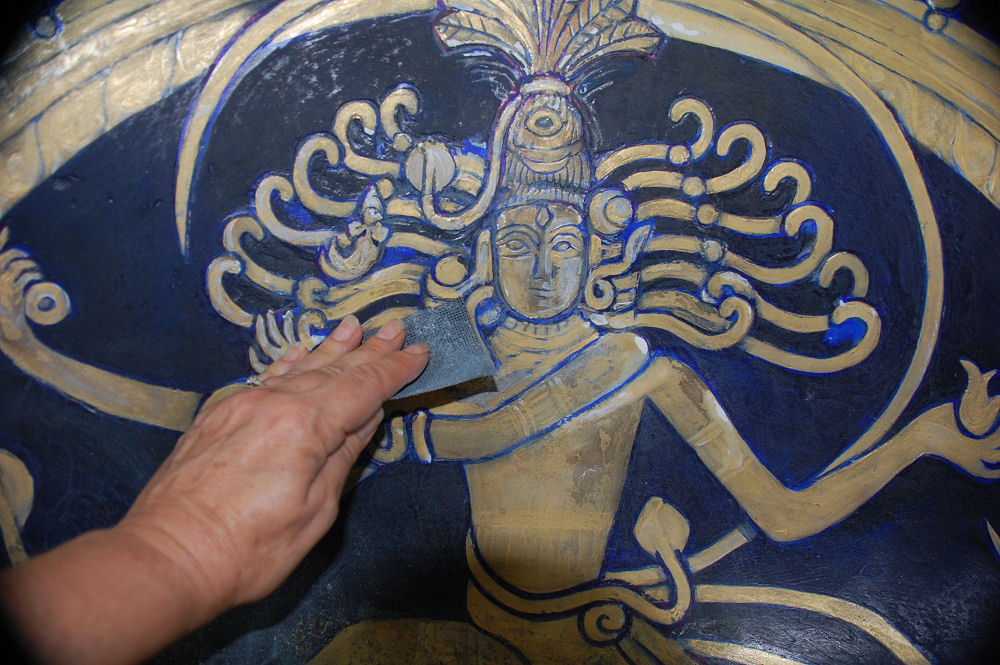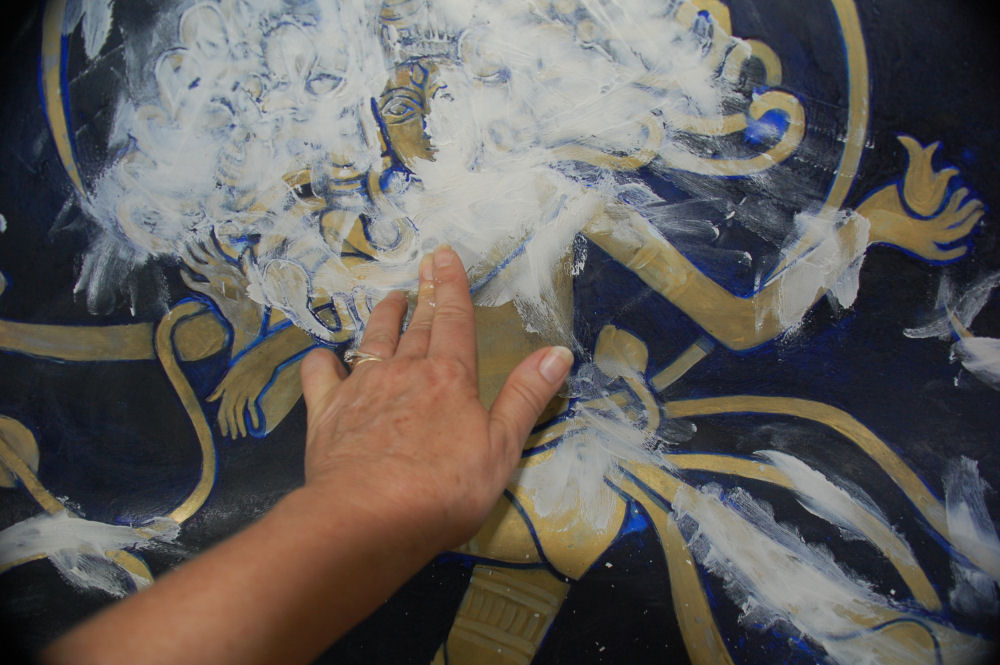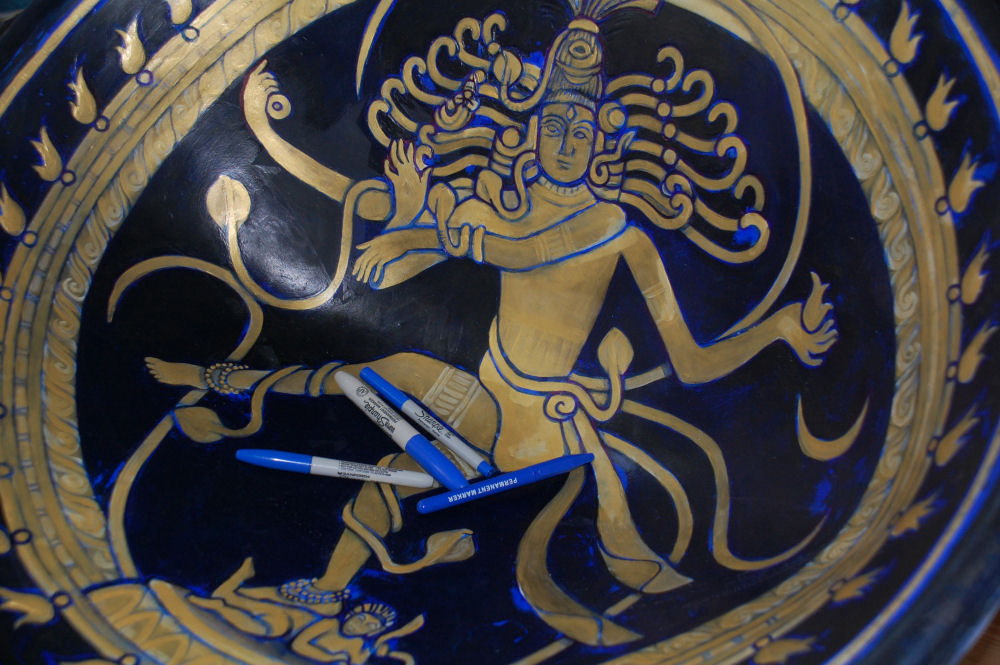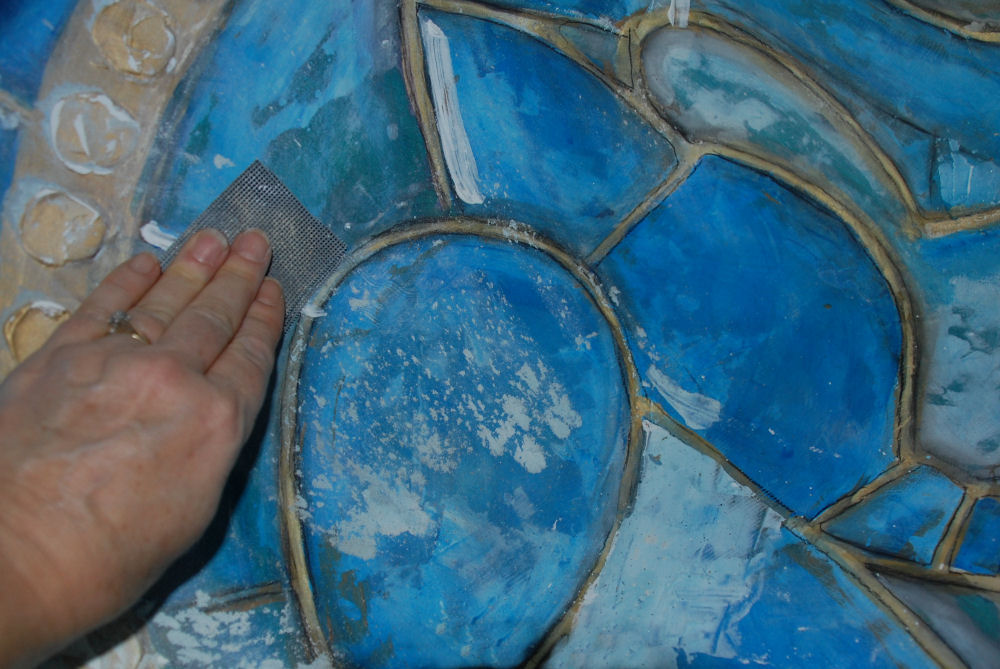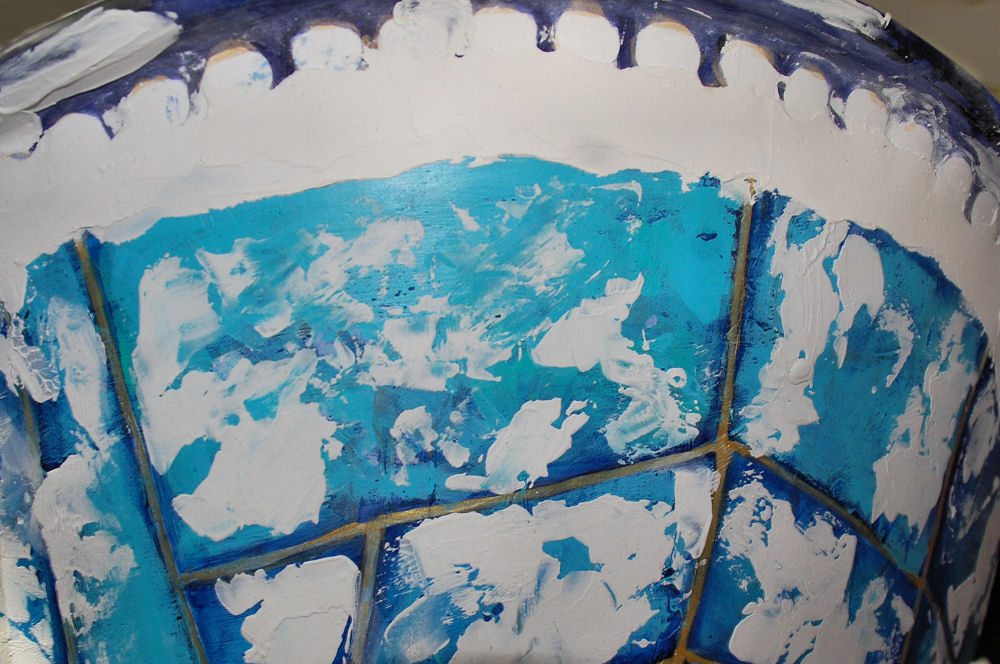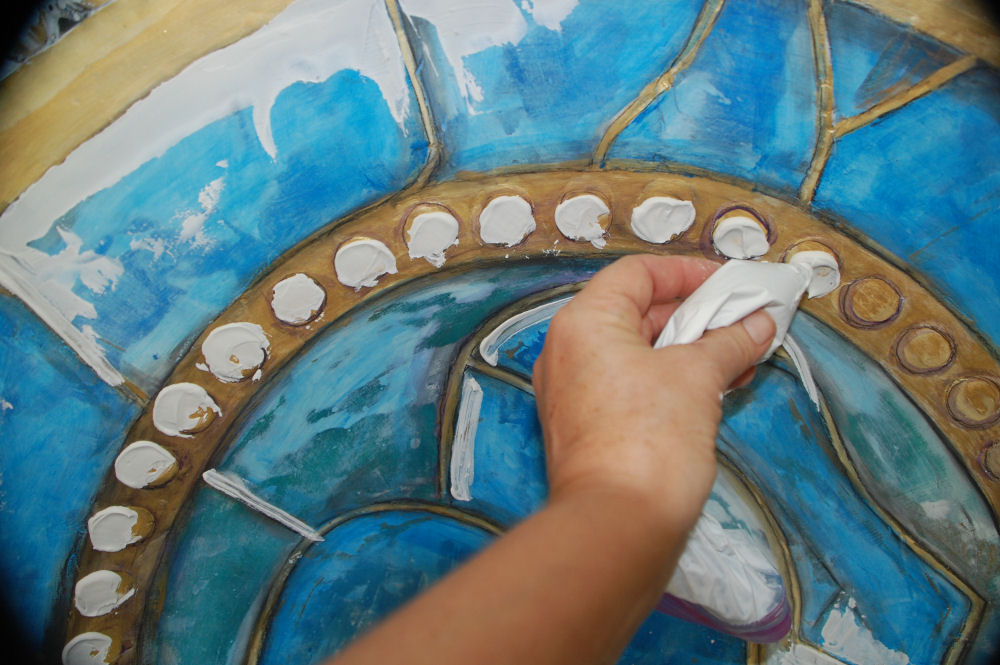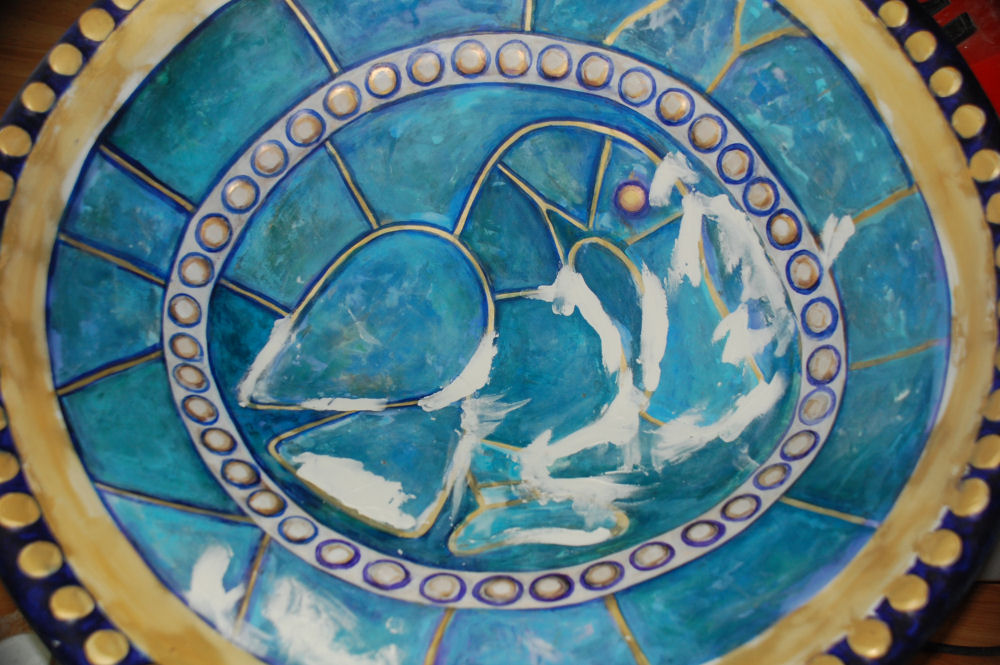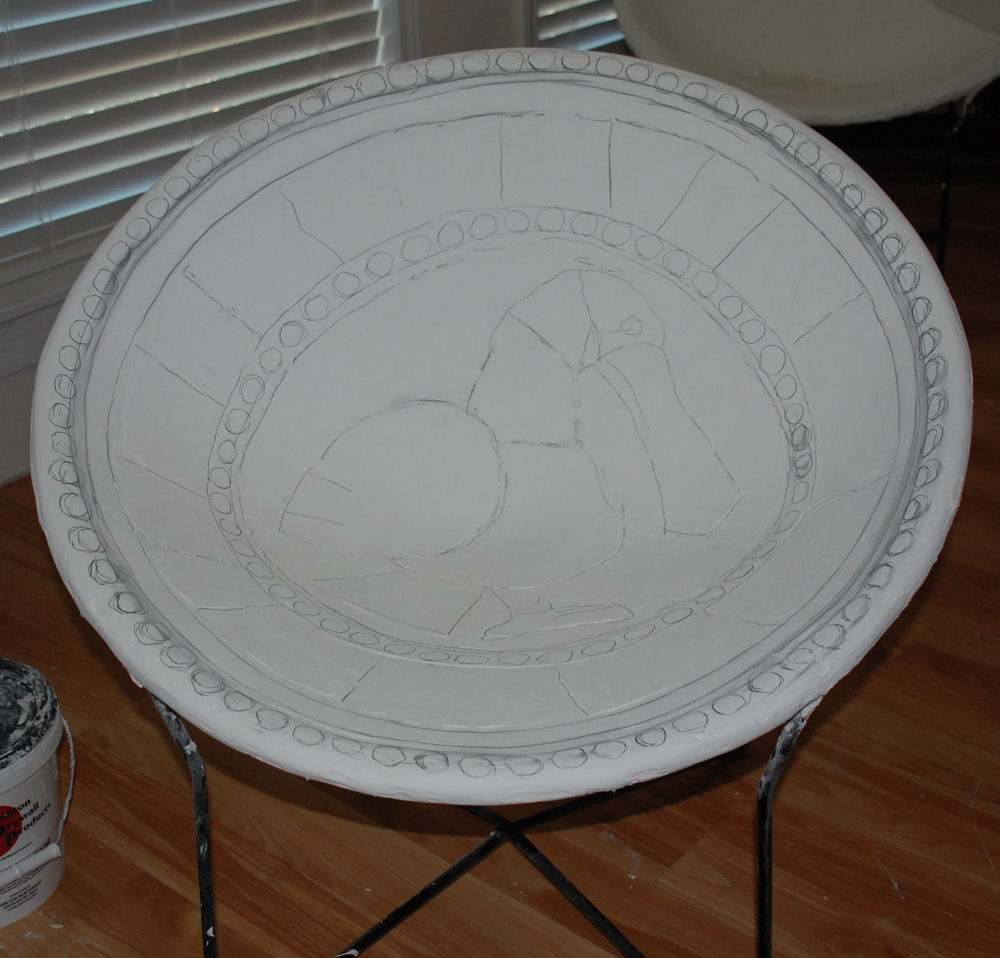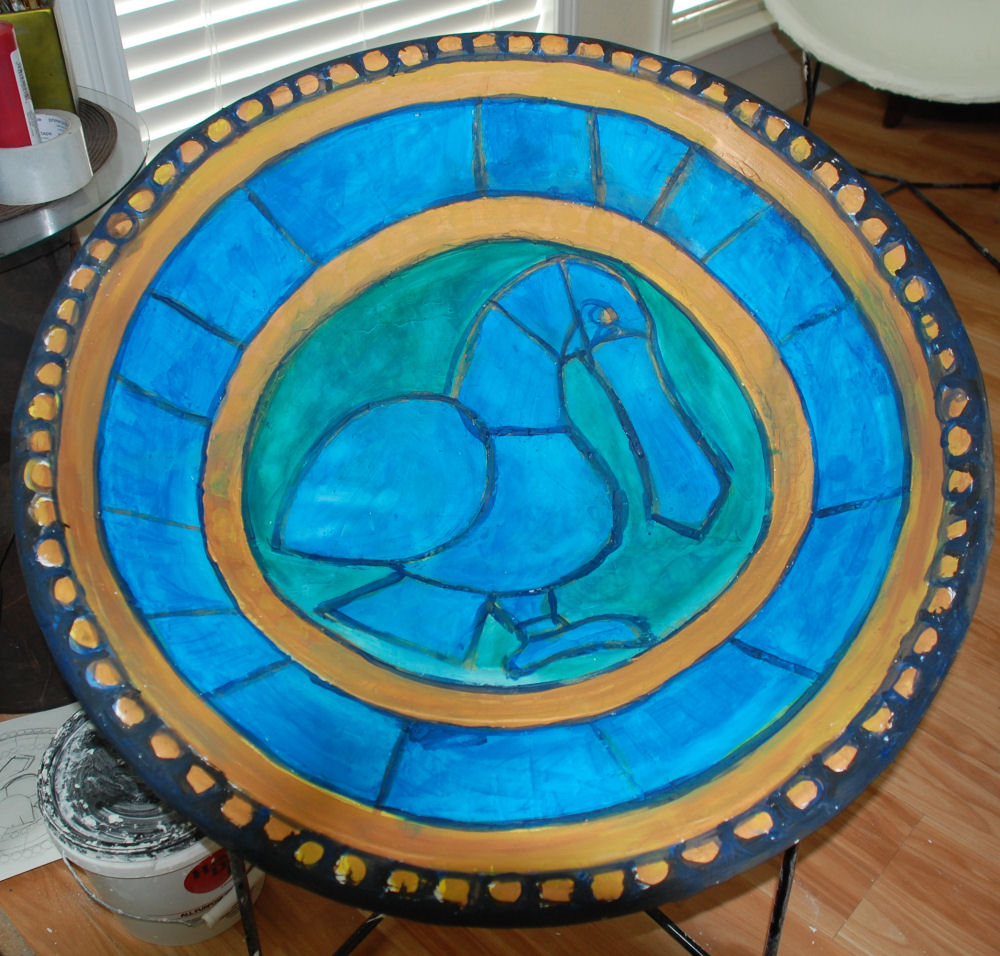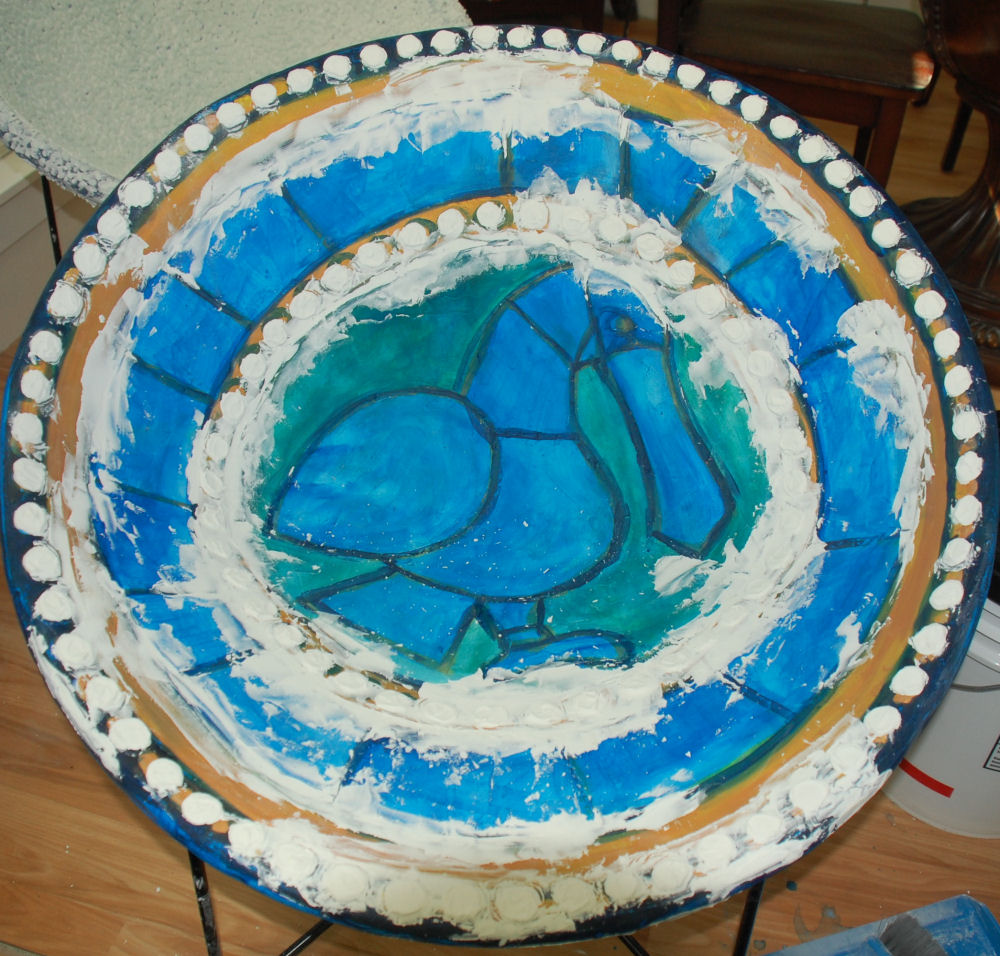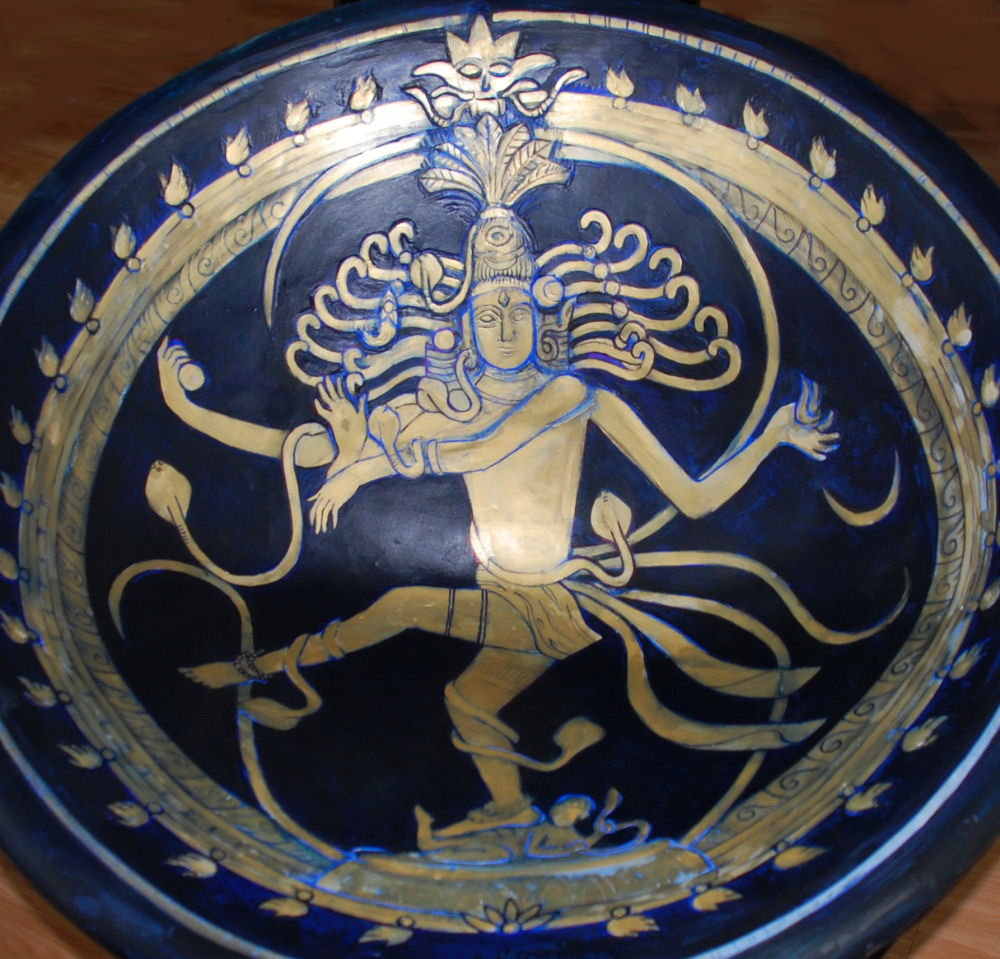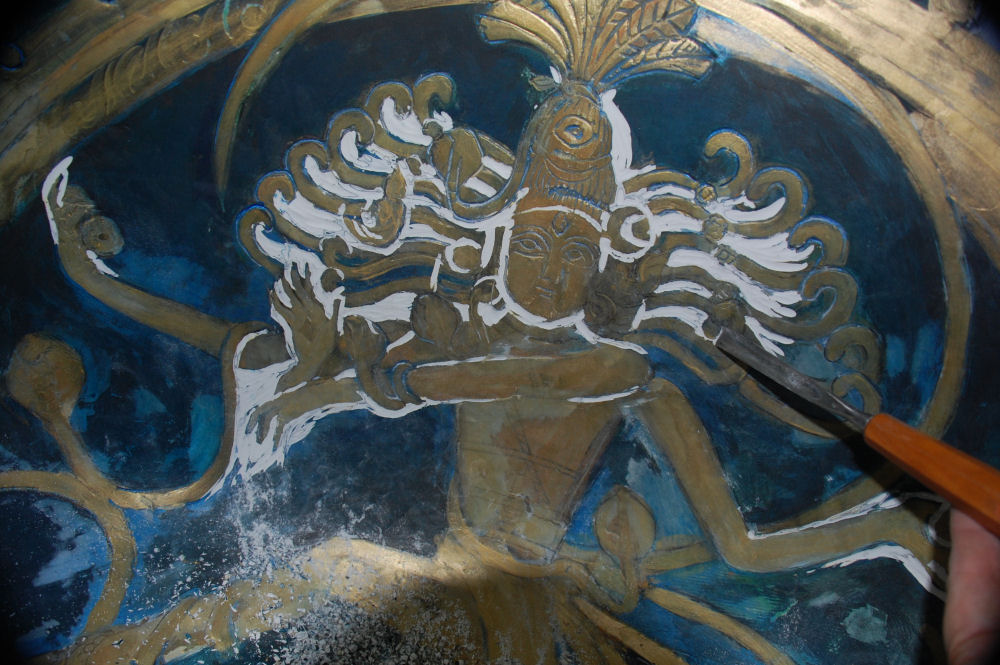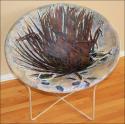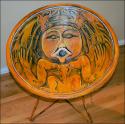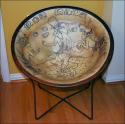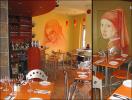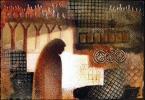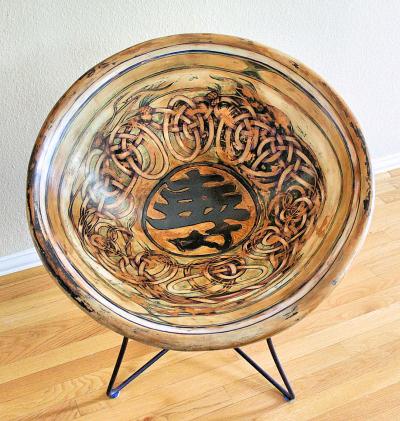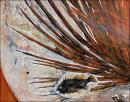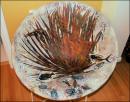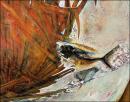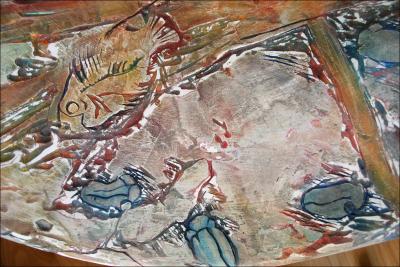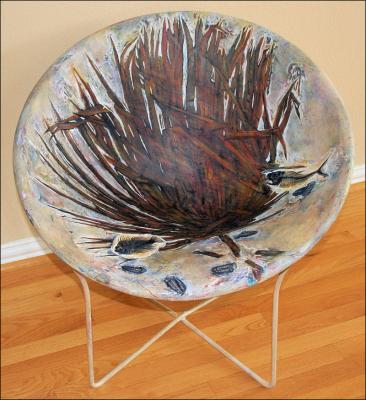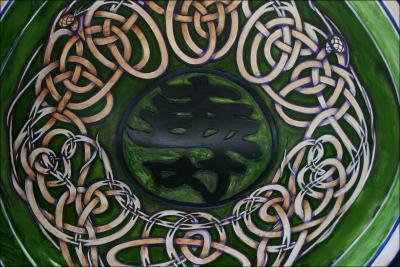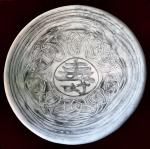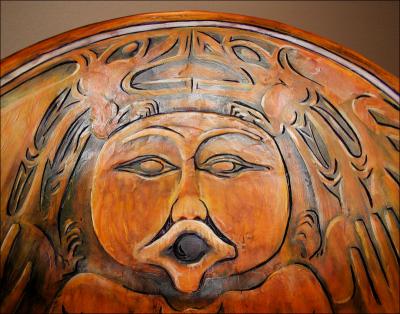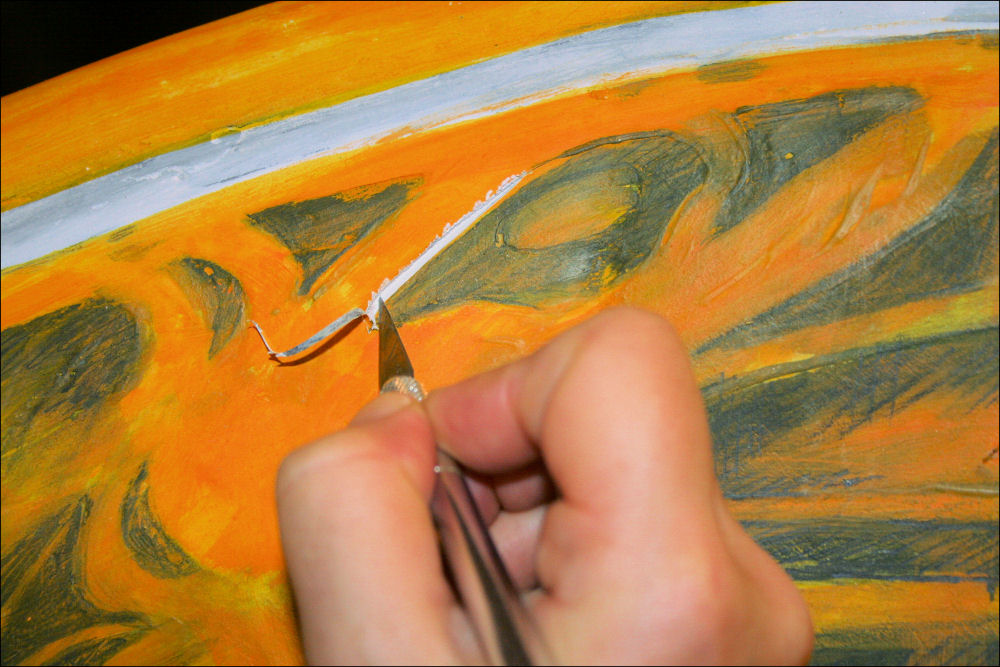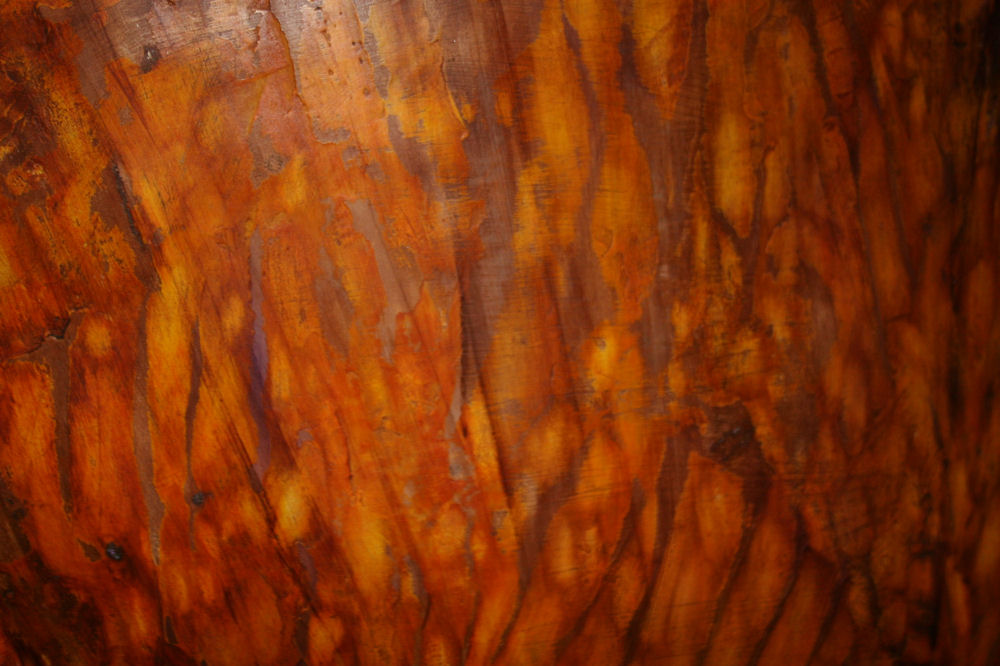history/multicultural theme
« Previous Entries Next Entries »Progress on the Shiva and Moche Earplug Replica Chairs
Tuesday, May 24th, 2016
The extra time working on each the Shiva, Lord of the Dance and Moche Earplug replica chairs means 1) increasing familiarity with the authentic originals, and 2) layers of color and contrast add patchy timeworn impressions which might not have otherwise occurred.
The Shiva statue design is so complex, in retrospect it might have been enough to paint it on a flat surface, like the Mayan Bowl replica chair. Certainly it would have been easier and might be finished by now, but in artwork, I am not always necessarily seeking the easiest way through. Ease is usually the result of something already learned. The point is to discover how to do something, learn how to resolve issues that are presented and/or self-imposed, and the energy is driven by those challenges.
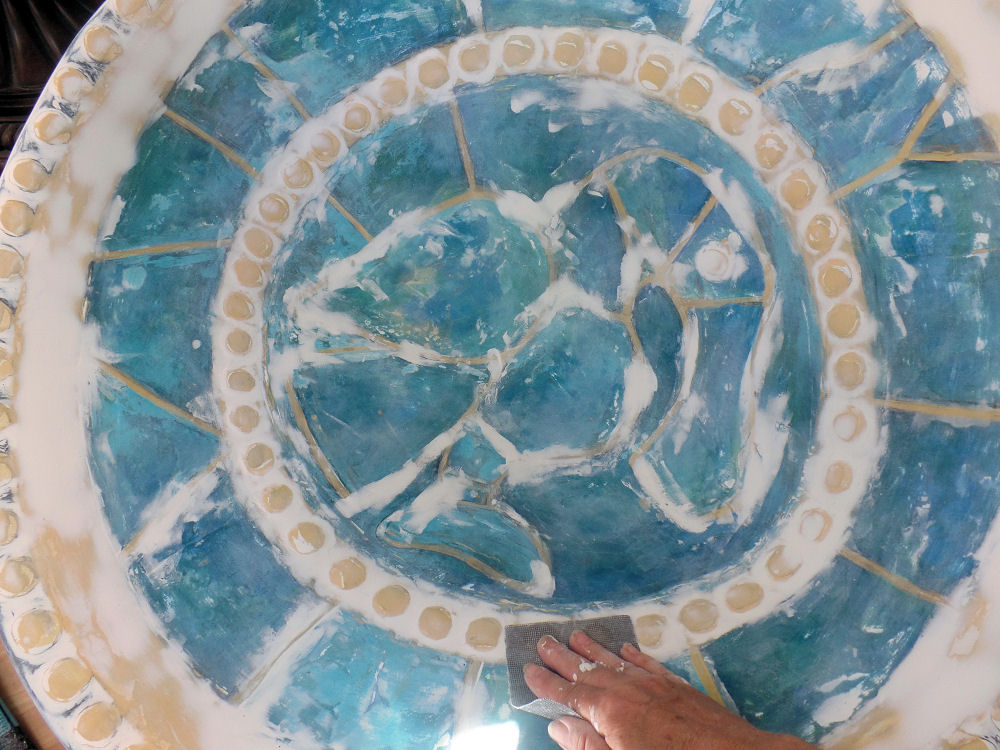
While staying true to the original concepts, I also applied artistic licence since the chairs are unique interpretations in their own right, so some of the designs are improvised slightly, like the ring of fire around Shiva, and the faux turquoise inlay design on the back of the Moche Muscovy Duck chair.
Some issues I’ve encountered: The water-based metallic gold paint reflects off every bump, dries and clumps quickly, and does not spread evenly compared to other acrylics colors even with additives, and the effects of build-up require extra sanding to keep the surface smooth. The overall sculpted effects of carving didn’t seem to make a difference aesthetically so I finally abandoned the idea last week. A lot has been filled in, but some carving is left to keep the hand-worked appeal.
Moche culture jewelry: Ear Plug replica Chair
Saturday, May 2nd, 2015
Started Moche Ear Plug replica chair, faux turquoise and gold, 29 x 29 x 29 inches mixed media furniture.
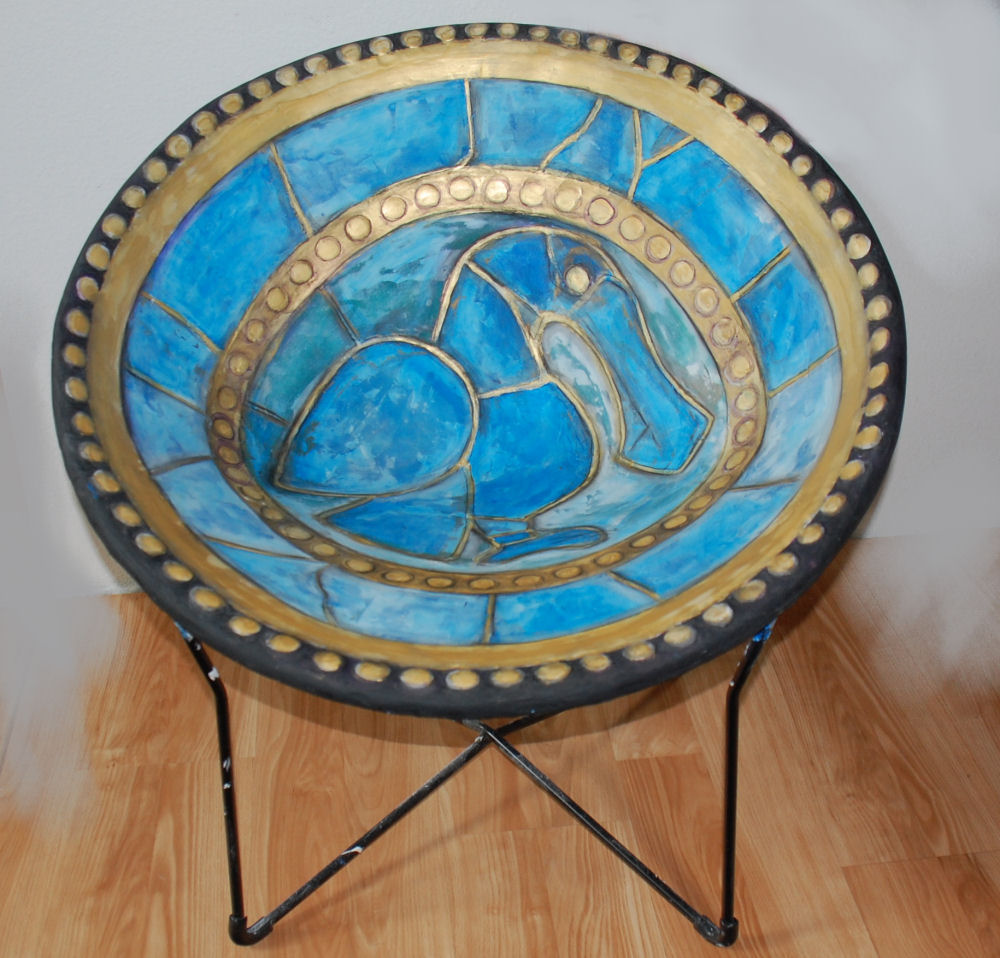
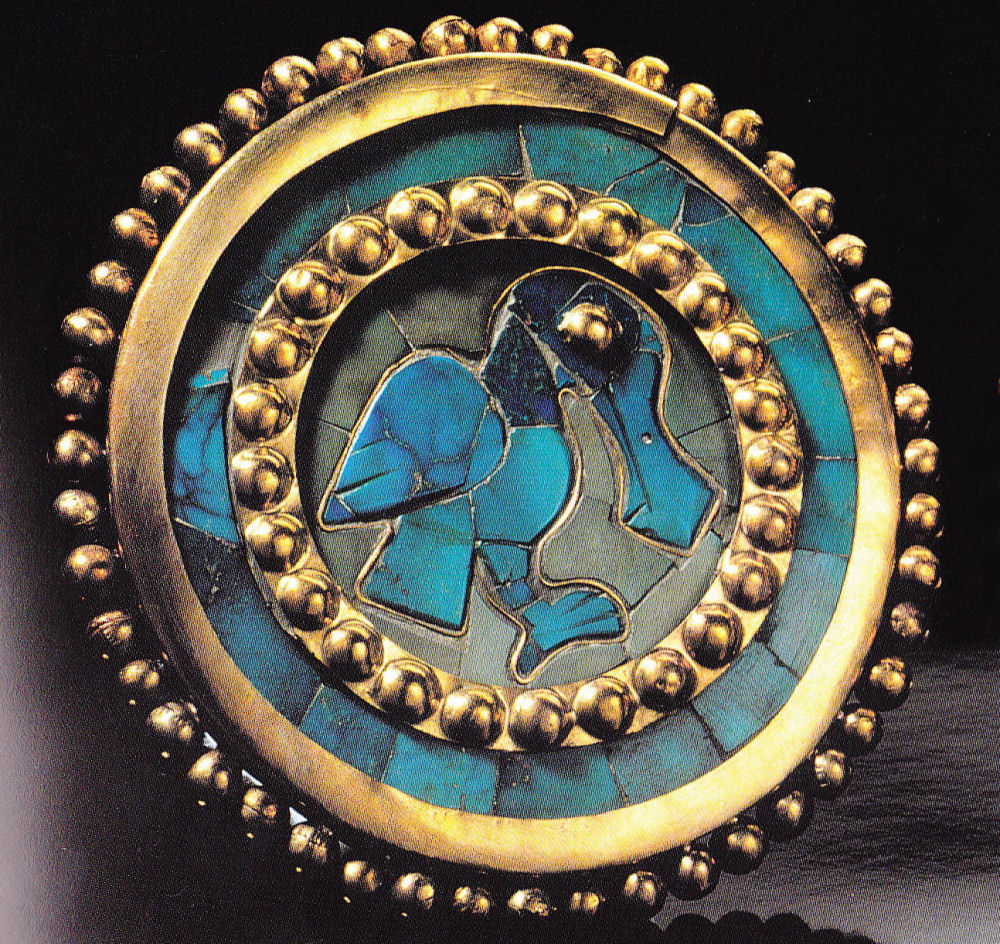 The Moche culture lived on the north coast of Peru between 100 BC and AD 700. With no writing system, they left incredible representations of their activities through art on clothing, pottery, jewelry, architecture, and hunting weapons, illustrating themes like ceremonies, supernatural beings and warfare. This chair is a replica of an Ear Plug – one from a pair found in the tomb of the Lord of Sipan, one of two large tombs discovered in 1987 just north of the village with the same name. Accompanied by sacrificed members of his court and wearing beautifully crafted cotton garments, the highly regarded king died at 30 years of age and was buried with ornaments, carefully placed crowns and various types of jewelry made of gold, gilded copper, shell, feathers, and precious gems. Over 250 ceramics were found, as well as figurines, banners, helmets, scepters and rattles.
The Moche culture lived on the north coast of Peru between 100 BC and AD 700. With no writing system, they left incredible representations of their activities through art on clothing, pottery, jewelry, architecture, and hunting weapons, illustrating themes like ceremonies, supernatural beings and warfare. This chair is a replica of an Ear Plug – one from a pair found in the tomb of the Lord of Sipan, one of two large tombs discovered in 1987 just north of the village with the same name. Accompanied by sacrificed members of his court and wearing beautifully crafted cotton garments, the highly regarded king died at 30 years of age and was buried with ornaments, carefully placed crowns and various types of jewelry made of gold, gilded copper, shell, feathers, and precious gems. Over 250 ceramics were found, as well as figurines, banners, helmets, scepters and rattles.
The Muscovy duck was a symbol of water abundance to Moche society, and they revered gold as symbol of the light and sun. The color gold is associated with higher ideals, spirituality, wisdom and understanding. For thousands of years, Turquoise mining and adornment has spanned all cultures, prized as a symbol of nobility, invoking luck, protection, and the power of immortality.
I love the idea of incorporating arts and cultural history in my work somehow. The up-cycled chairs are the perfect place to do this. Here are some examples of the influence of history on previous art work.
New Chairs in progress – first, Shiva as Nataraja
Friday, May 1st, 2015
Shiva as Nataraja chair in progress
The Lord of Dance symbolism
Eastern philosophy is full of symbolism for concepts much deeper than words could ever express. The teachings are so complex but beautifully simple at the same time. Divine concepts are depicted in human forms with worldly items to help us identify somewhat, and increase our understanding toward making healthy decisions in our lives – for mind, body, and soul.
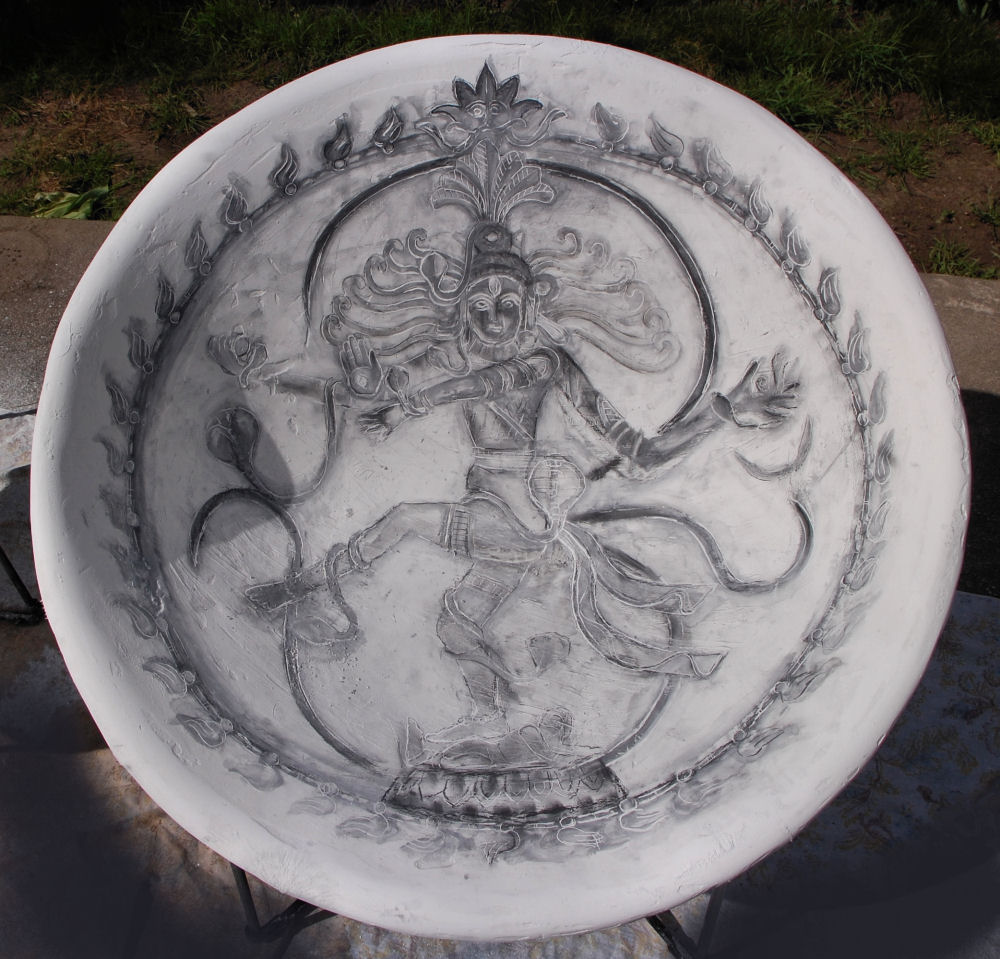 Sculptures, pictures, and literature are charged with multiple meanings and contradictions conveying the extremes in Life, like the existence of intense joy and pain, and the importance of balance in day to day living, and practicing a middle road of contentment. The interpretations here only outline the more prominent symbolism of this famous icon. As research continues, this article will elaborate on the most important symbols of this sculpture.
Sculptures, pictures, and literature are charged with multiple meanings and contradictions conveying the extremes in Life, like the existence of intense joy and pain, and the importance of balance in day to day living, and practicing a middle road of contentment. The interpretations here only outline the more prominent symbolism of this famous icon. As research continues, this article will elaborate on the most important symbols of this sculpture.
The purpose of the dance is to release us from our ignorance and entanglement in the world of opposites, all set within the circular, rhythmic motion of the universe. We are to acknowledge, yet remain detached by their effects. It is said that Truth requires detachment and at the same time, knowledge and acceptance.
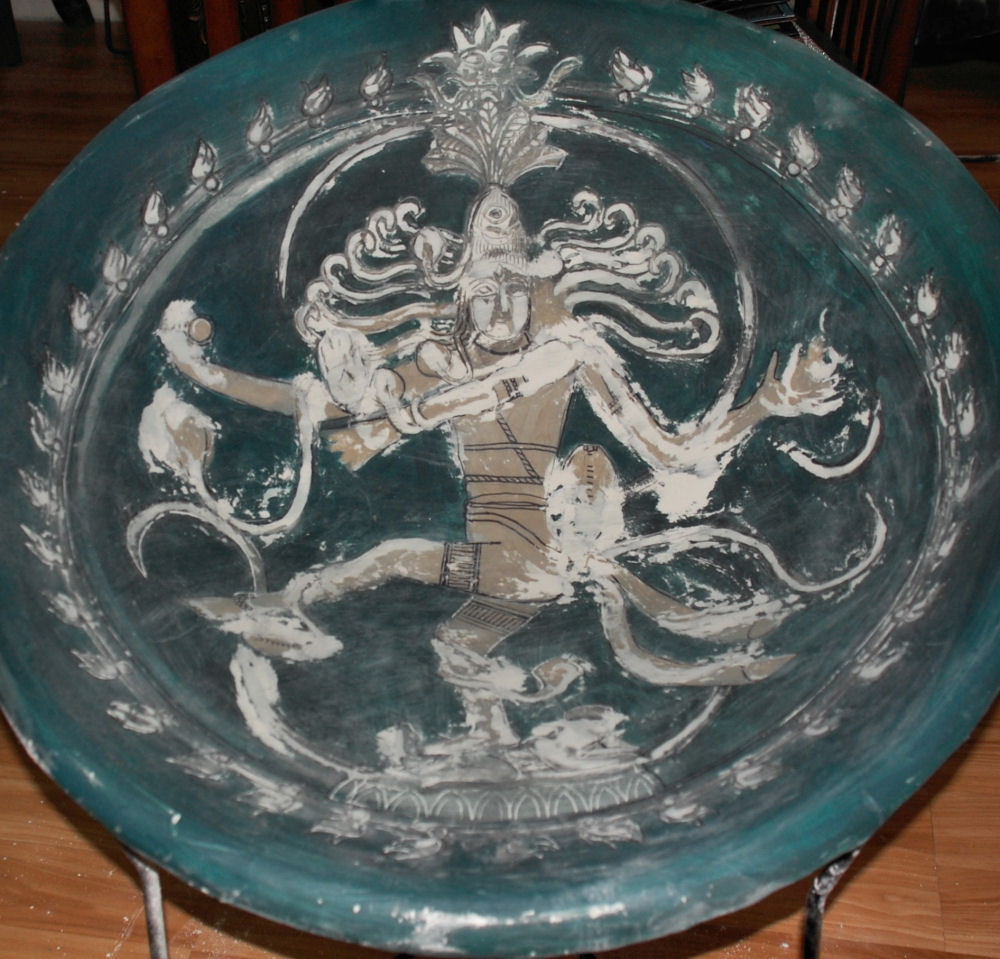 There are different names for the Hindu god, Shiva in his various forms. Though an ascetic, Shiva’s role is as householder, implying that we need not leave society to be devoted to following principles of Dharma; conduct; right way of living. In the aspect depicted here, Lord Shiva creates, sustains, and destroys life. As The Nataraja, he dances within the world of illusion, represented by an outer ring of fire. There is an inner ring of water, and some statues show multiple rings of fire and water. As he victoriously dances upon the demon of ignorance, Shiva’s matted dreadlocks whirl about him, capturing a number of heavenly bodies, like the physical representation of the sacred river Ganges, which fell from heaven to earth, first landing in Shiva’s hair so as not to destroy it. The moon is symbolic of many things, such as seasonal changes, life’s rejuvenation and love, all kept active with this dance.
There are different names for the Hindu god, Shiva in his various forms. Though an ascetic, Shiva’s role is as householder, implying that we need not leave society to be devoted to following principles of Dharma; conduct; right way of living. In the aspect depicted here, Lord Shiva creates, sustains, and destroys life. As The Nataraja, he dances within the world of illusion, represented by an outer ring of fire. There is an inner ring of water, and some statues show multiple rings of fire and water. As he victoriously dances upon the demon of ignorance, Shiva’s matted dreadlocks whirl about him, capturing a number of heavenly bodies, like the physical representation of the sacred river Ganges, which fell from heaven to earth, first landing in Shiva’s hair so as not to destroy it. The moon is symbolic of many things, such as seasonal changes, life’s rejuvenation and love, all kept active with this dance.
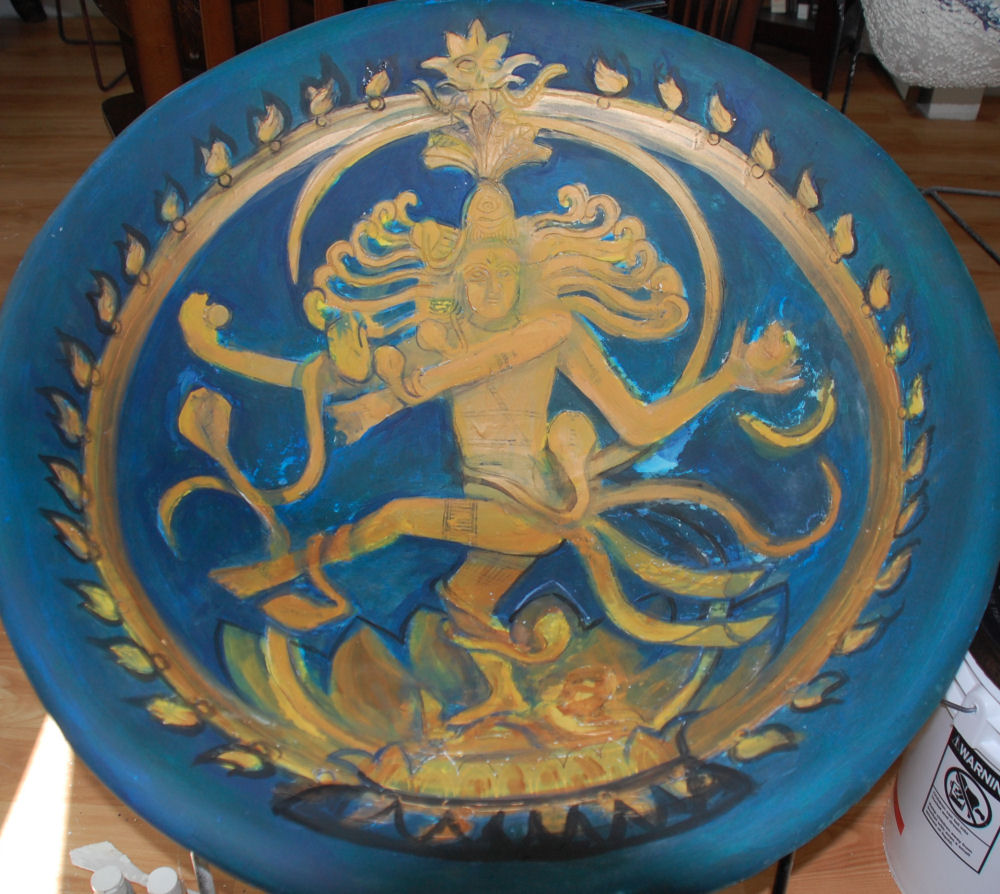 The gestures of the dance represent Shiva’s five activities: creation – symbolized by the drum, protection – the “fear-not” pose of the outward-facing hand, destruction – by the fire, embodiment – by the foot planted on the ground, and release – by the foot held above ground. Snakes coiling about his body symbolize the life force within all of us – the Shakti or kundalini – and display his power over the most deadly of creatures. Also, as snakes shed their skin, so do our souls reincarnate, according to Hindu beliefs.
The gestures of the dance represent Shiva’s five activities: creation – symbolized by the drum, protection – the “fear-not” pose of the outward-facing hand, destruction – by the fire, embodiment – by the foot planted on the ground, and release – by the foot held above ground. Snakes coiling about his body symbolize the life force within all of us – the Shakti or kundalini – and display his power over the most deadly of creatures. Also, as snakes shed their skin, so do our souls reincarnate, according to Hindu beliefs.
The first four first four Chairs were up-cycled second-hand store original Solaire Chairs, but I have found a decent source for newer ones, so finally some ideas I’ve had for years can be realized, and special orders can now be filled. With thin applications of plaster then sanding and waiting for successive layers to dry, four new Chairs, 29H x 29W x 29D inches, started April 5th are now in progress, concentrating on the details of two while the others cure. One chair, the priority, is of Shiva as The Lord of Dance, and one chair is an addition to the Zen Garden series. The third is a large replica of a Moche culture (1st century Peru) earring/ear plug, and the fourth chair will portray an Easter Island theme, something I’ve had in mind since I bought the very first chairs in the 1990’s. Until refining stages, the four can be worked at the same time while plaster is added, cures and is sanded down.
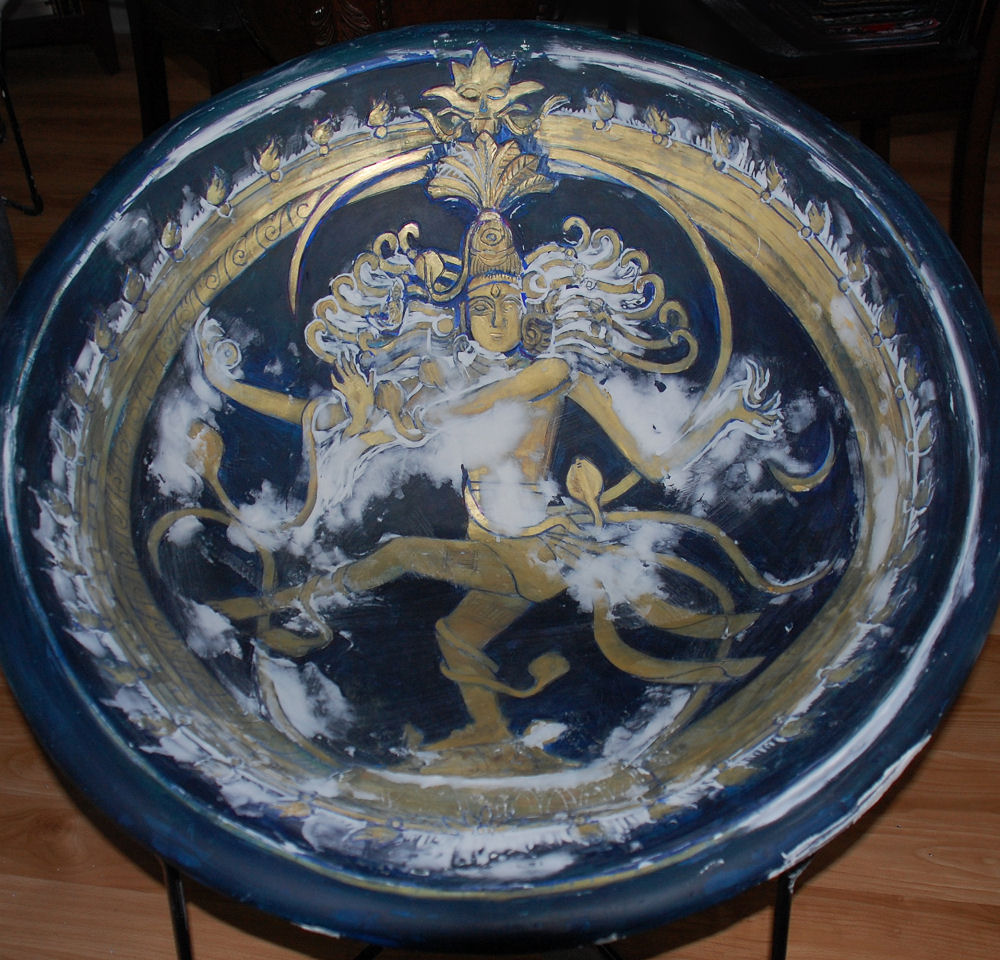 In this visual translation, the symbol of Om, first sound uttered in the Universe, weaves throughout, as if to involve a complete sensory understanding. All hand gestures have specific meanings, like the open front right hand facing us in “abhayamudra” gesture, denoting reassurance and safety for all who follow a righteous path. The drum in his right hand beats ceaselessly and infinitely, “Om”, while the universe is created, destroyed and recreated. The back left hand holds flames of fire, with both destructive and cleansing properties. The front left arm is held across the chest like an elephant’s trunk, with the hand pointing to the left leg and foot, lifted as a sign of liberation as the sacred elephant leads the way through jungles of ignorance.
In this visual translation, the symbol of Om, first sound uttered in the Universe, weaves throughout, as if to involve a complete sensory understanding. All hand gestures have specific meanings, like the open front right hand facing us in “abhayamudra” gesture, denoting reassurance and safety for all who follow a righteous path. The drum in his right hand beats ceaselessly and infinitely, “Om”, while the universe is created, destroyed and recreated. The back left hand holds flames of fire, with both destructive and cleansing properties. The front left arm is held across the chest like an elephant’s trunk, with the hand pointing to the left leg and foot, lifted as a sign of liberation as the sacred elephant leads the way through jungles of ignorance.
The graphite design is first partially engraved with pencil in damp plaster, helping to show which areas to raise and hwich to recede. The addition, removal by sanding and carving gradually refine the design along with successive layers of paint which, when finished, the combination shows through as a mottled sort of patina, perfect for this subject. The icon on the finished chair will be gold-bronze colors, as the Shiva as Nataraj sculptures are traditionally made of bronze. Plans are for the background to be antiqued cobalt blue or teal.
Toil and Peaceful Life
Wednesday, July 7th, 2010
“Art is a human activity having for its purpose the transmission to others of the highest and best feelings to which [humanity has] risen.”
Leo Tolstoy
Creating art is always a personal endeavour, and every so often I’m drawn to study only for the deeper experience of it; for the kind of education and understanding that can’t come through reading or any other means. Here is a painting I started in May, along with links and information about a unique part of Canadian history that many Canadians are not even aware of, a group of Russian immigrants who made significant contributions to, and the development of, the Canadian prairies. Next week I’ll be driving up to Alberta through Blaine Lake, Saskatchewan where some of the Doukhobors, whom I’ve just recently learned are part of my own heritage, settled during the 19th century. Upon returning from this final leg of summer travel there is another painting commission to complete, so I’ll be blogging regularly again and finishing this painting in about two months.
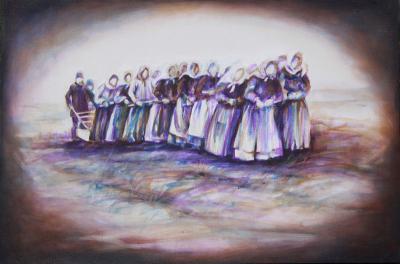
“Toil and Peaceful Life” (quote, Peter V. Verigin), 24 x 36 x 2 inches acrylics on canvas. Study only, NFS, work in progress: There are harsh contrasts and colors at this stage, so am planning to paint over the whole surface with my friend Virginia’s white wash formula (1/2 guesso, 1/4 matte medium and 1/4 water), then will gradually bring out details again by scrubbing areas away with a wet cloth and repainting as well. Further layers of siennas, umbers, pale yellows, unbleached titanium washes etc. will be treated the same way.
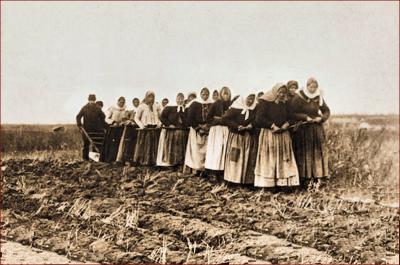 When the light bulb on my sewing machine burnt out – it won’t work without one – I could have hopped in the car and driven three blocks to go buy another, but instead made due hemming a garment by manually spinning the wheel on the machine. I had already started the above painting referring to an old photo of 16 Doukhobor women pulling and two men directing a plow as they tilled the land in southern Manitoba, Canada’s eastern-most prairie province, during the late 1800’s. This is one of the more powerful images portraying the character of the Doukhobors, who left their homeland in Russia because of religious persecution, never allowed to return, becoming the largest mass immigration in Canadian history.
When the light bulb on my sewing machine burnt out – it won’t work without one – I could have hopped in the car and driven three blocks to go buy another, but instead made due hemming a garment by manually spinning the wheel on the machine. I had already started the above painting referring to an old photo of 16 Doukhobor women pulling and two men directing a plow as they tilled the land in southern Manitoba, Canada’s eastern-most prairie province, during the late 1800’s. This is one of the more powerful images portraying the character of the Doukhobors, who left their homeland in Russia because of religious persecution, never allowed to return, becoming the largest mass immigration in Canadian history.
I’ve often wondered how it must have been for women in the past, considering all of the chores that raising a family and taking care of the home must have entailed. On top of that, there was little relief from extreme weather conditions as, for example, during the heat of summer all of these responsibilities were done wearing long dresses, petticoats and bonnets. I guess it was with this in mind that I endured impatiently sewing my jeans without electricity.
The small amount of soil I turn over in the garden is planted mostly with flowers. The few veggies that are novel to watch grow from seed to fruition are not crucual to the survival of my family. While I’m purchasing ready-wound thread on a plastic bobbin, I can select from a number of food choices and shop during any time of day, 24 hours a day in a 7 day week. Todays’ lifestyles are so far removed from the realities that pioneers in any land must have faced. Living in small communities where all could share the work as well as morally support each other made complete sense. So it was for the Doukhobors, living a philosophy very similar to the Hutterites, the Mennonites, and the Amish.
Photos are photos and paintings are paintings, but as traditional artists we can take advantage of the art of photography as inspiration to trigger motivation and memories, recreate impressions, and refer to for details. If photos are used as reference, very soon after painting begins I rely on and respond more to what’s happening on the canvas. For some time before putting brush to canvas, every detail of a subject adds to an internal mental picture, one that gradually envisions the painting finished to a certain degree. In some cases I’ll work from pictures of historic art or artifacts as educational studies, or from a client’s photo if they commission the reproduction of a favorite scene. Always though, the resulting art is an emotional translation.
The first thing that strikes me in the enlarged re-re-reproduced print I’m working from is how little the quality of the image matters. The shadows on the faces of each individual say it all. Some appear curious about having their photo taken, and most are more concerned about the task at hand. Though the image is crude by modern standards, and maybe even partly due to it, we are able to share the raw truth of a moment in one of an uncountable number of cultures throughout human history who worked so physically this way. For most of our time here on earth, we, like all of nature, knew we depended on the land, and it truly was survival of the fittest. I can only hope to capture the calibre of this story as well as the photo does.
Sometimes a painting can never be as effective as a photo, particularly when it comes to human portraits. In intances like this, there is so much value in “the journey” of your efforts. Painting such a scene, it really is like being transported. Of course the goal is to make the work successful, and artists all hope and plan for sales, but we also need to make time for creating work that feeds our soul and brings us back to the inner sources that pulled us into this not-always-externally-fulfilling vocation in the first place. When I recommend forgetting the rules and listening to your own, that’s what I mean. Even if you have never tried to paint or draw before, or you think you don’t have enough skill, you are as capable as anyone if you are spurred on by your emotions toward subjects you love, using whatever methods you enjoy.
Facebook – group intro:
“Toil and Peaceful Life”
The name Doukhobor means “spirit wrestler”. Although many of their beliefs descended from Christianity, being a Doukhobor is more of a way of life than a religion. Doukhobors are a group of pacifists that came to Canada from Russia to escape persecution for their beliefs at the end of the 19th century. The most well known leader of the Doukhobors was Peter ‘Lordly’ Verigin. The Doukhobors established communites across Western Canada, many times cultivating land that was not seen as desirable. There are still reminants of Doukhobor villages primarily in British Columbia and Saskatchewan.
“…The settlers found Saskatchewan winters much harsher than those in Transcaucasia, and were particularly disappointed that the climate was not as suitable for growing fruits and vegetables. Many of the men found it necessary to take non-farm jobs, especially in railway construction, while the women stayed behind to till the land…”
Susan Wiley Hardwick, “Russian Refuge: Religion, Migration, and Settlement on the North American Pacific Rim”. University of Chicago Press, 1993. ISBN 0-226-31610-6. 1993. Section “The Doukhobors”
http://en.wikipedia.org/wiki/Doukhobor
The Doukhobors: 16th Century Russia to Canada, 2010
The origin of the Doukhobors is fairly dubious, but some information dates the culture back to 16th and 17th century Russia. Deeply spiritual, the “Doukho-borets”, which literally means “spirit wrestlers”, rejected common orthodox practices of organized religions and society, including the worship of icons and individual land ownership. As pacifists, their motto was “Toil and Peaceful Life”.
After refusing allegiance to Tsar Nicholas and military service, in 1895, they burnt all of their weapons in response to this. (The date, June 28th, has become a day of celebration of their humble roots.) Facing persecution for their beliefs, over 7,000 Doukhobors sought refuge in Canada starting in 1899.
The Doukhobors’ passage across the Atlantic Ocean was largely paid for by Quakers and Tolstoyans, who sympathized with their plight, and by the writer Leo Tolstoy, who arranged for the royalties from his novel Resurrection, his story Father Sergei, and some others, to go to the migration fund. He also raised money from wealthy friends. In the end, his efforts provided half of the immigration fund, about 30,000 rubles.
* Multicultural Canada http://multiculturalcanada.ca/node/48207
With sympathy from the Canadian government, for a $10 fee each adult male was intitially provided with 160 acres of “free land” on the prairies of central Canada; present day Saskatchewan and Manitoba. They were expected to live on and break the land, plant crops, and eventually apply for a patent to own it.
During 1906, a new Parliamentary Minister revised their previous agreement to laws that commanded a pledge of allegiance to the Crown or else lose their homesteads. In 1907, 2,500 homesteads were cancelled, causing communal splits into three distinct groups. The largest group of Doukhobors, incuding Peter Verigin, the man who had re-documented and defined their Orthodox faith, moved to British Columbia. The “Sons of Freedom” also went to B.C., but were radically different than the Community Doukhobors. They actively protested (sometimes nude!) issues arising from Canadian governmental control over their way of life, creating misunderstandings and negativity toward Doukhobors in general that remain to this day. The “Independents” maintained their homesteads in Saskatchewan in compliance with the new Canadian laws.
1908 to 1912: Peter Veregin’s group purchased land in the West Kootenays, B.C. and developed large communal enterprises. The Doukhobors now call themselves the Christian Community of Universal Brotherhood (CCUB), situated in Brilliant, B.C..
Video http://www.youtube.com/watch?v=Kp5umD3HA8k
Good things come in threes
Wednesday, February 10th, 2010
Cycad Fossil Chair, Salish NW Pacific culture wooden whorl replica Chair, and Ancient Mayan bowl replica refurbished vintage chair, 29 x 29 x 29 inches mixed media. Read the feature article.
On exhibit and available for purchase February 11th – 27th at Visual Image Fine Art Puiblishing and Gallery Juried Show, 14320 Midway Road, Suite 300, Dallas, Texas. Come and meet all the Artists at the Opening Reception this coming Saturday, Feb. 13th, 3 – 9 p.m.
~
Good Artist Pals also come in threes
Some friendships will last forever, and how fortunate that three of mine also happen to be artists! Listed in no particular order of favoritism, each are miles apart geographically speaking and personality-wise, but they all have one thing in common: they’ll tell it like it is if you ever need a good critique, and on the flip side of the coin: a smile, a boost of energy; encouragement. I’ve posted my favorite works created by each, and highly recommend browsing each of their websites..
a) Chris Bolmeier: Happy Pigs, Oil on canvas I met Chris on the internet three years ago through Robert Genn’s Painter’s Keys newsletters. Formerly an actress and professional singer, she’s not through yet with entertaining you through humour, song and paint. She often posts mini-videos of herself singing, and her artwork is pure, straight from the gut, and some of the funniest, most original material ever. I chose this piece to share as an absolute favorite, portraying fanatically goofy pigs because it makes me laugh…not just smile, but laugh Christerically every time I look at it. In my opinion her best work is of childhood memories, and some of the baffling stuff that originates from who knows where in the infinite canvas of her mind!
b) Karen Xarchos: Restaurant mural in Ottawa, Ontario, Canada Karen and I were neighbors many years ago. We designed and painted murals together in the Ottawa area for a couple of years. Thank goodness for the internet, we’re able to keep in touch when either of us needs a good eye and some honest advice. Karen’s style and mine are vastly different; our pace, the style, the manner and we continue to learn so much from each other. She reminds me to slow down and smell the paint; her blending techniques are amazing.
Karen accepts commissions for canvas pieces like wall borders painted at home, then cleverly installs them with wallpaper paste so home owners can remove the work and take it with them when they relocate. My favorite work of Karen’s are the murals depicting work of the Masters, which are enjoyed by customers dining in many of the Greek and Italian restaurants in the Ottawa area.
c) Virginia Wieringa: Prayer, mixed media collage Virginia and I met about four years ago on an Artists’ interactive website, wetcanvas.com, and I think she still participates there under the avatar name “Veedubya”. I’m positive she’d love to meet you there too. Virginia has well-developed drawing and painting abilities and currently experiments intuitively with mixed media collage. Her work, no matter what the media, reflects her open-mindedness and strong sense of spirituality. Formerly an Art teacher, she’s fun to write to because she puts up with my inner-most silly self and doesn’t hold back her own. My favorite work of Virginia’s are the subtly symbolic collages, and some of the more vivid, energetic paintings that are about two phases pre-Realism.
The Tree of Life Chair
Monday, November 30th, 2009
The Tree of Life, 29H x 29W x 29D inches mixed media; refurbished vintage plastic lawn chair, woven canvas strips and white glue, thin layers of drywall compound: cured, sanded, carved, acrylics paint, varnish. Durable, completely functional.
There was an interesting buildup of colors after a lot of changing colors and repainting the design many times, so the impressions of this chair are created like the other chairs in this series; ancient artifact replicas. The other chairs are listed here.
The Evolution of Communication
Tuesday, November 3rd, 2009
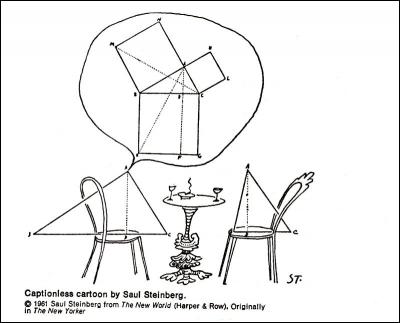 The title of a work of art can help sell it, and captions can complete our understanding of a picture, but the most successful works of Art manage well without an explanation. Our visual senses – sight and insight – have a language of their own. Upon viewing anything, multitudes of information are presented and understood simultaneously, almost instantly. With or without color, images are powerful, possibly even more than words, because with the development of human communication, pictures came first. It’s now widely accepted that symbols marked the origins of written language across the world.
The title of a work of art can help sell it, and captions can complete our understanding of a picture, but the most successful works of Art manage well without an explanation. Our visual senses – sight and insight – have a language of their own. Upon viewing anything, multitudes of information are presented and understood simultaneously, almost instantly. With or without color, images are powerful, possibly even more than words, because with the development of human communication, pictures came first. It’s now widely accepted that symbols marked the origins of written language across the world.
It takes much less time to perceive than it does to write about it. For a hands-on illustration of this, draw a simple Smiley Face, and note the time that it takes to draw it. Afterward write down everything that comes to mind about that icon; what it means, other general impressions and associations. Although this is a familiar icon with clear connotations, possibly something we see every day now, plus almost all of us have drawn it at some point, within seconds of describing it you will realize how much longer it takes to interpret as quickly into words. Harvey Ball, the original artist of the Smiley Face icon must be flabbergasted that succeeding generations would come to coin the term, “emoticons”, based on an indefinite number of facial expressions that spawned from the first, including animated ones that wink and cry, and more.
Essentially, full comprehension in any language relies on those aspects of our mind’s eye: memories and imagination in order to be fully effective. Pictures appeal to our abstract, multidimensional experiences and through the emotions, allowing for individual’s interpretations. There are higher expectations for words. We assume that they alone are qualified when we’re talking on the phone and participating in online computer groups, for instance, but it actually takes extra effort for our intent to be clear when we don’t have access to the visual side of our statements. Even if we speak the same language, the words we choose and their meaning can be misinterpreted and misunderstood.
Relying on the visual aspects of learning, subjects in school are traditionally taught using chalkboards and eraser-boards, stimulating audio and visual senses. Likewise, motivational speakers often use diagrams to help get the point across. The use of imagery is rampant everywhere now. It’s extremely effective in all forms of advertising, and despite all attempts to hold on to all copyrights, if the art is relatable it spreads like wildfire on the internet. Artists of every kind are more vulnerable than ever to fraud.
Harvey Ball’s Smiley Face is a perfect example of how artists are not really in control of what they create. Generally though, any exposure is good exposure, because most people who borrow other people’s graphics or ideas still want to know who the source is. As artists it’s beneficial and constructive for us to continue moving on to the next best project and keep progressing with a lifetime of work. We have to learn to let go of the strong bond we have with the art we create. It’s personal, to be sure, but a good motto is, “There’s more where that came from”.
Along with the resources available to us now, in our progressive age of high technology and wireless everything, it’s still the Human factor that needs refining. We only need to trust intuition as much as logic, with as much emphasis on communicating our emotions as openly and explicitly as we do words and speech. Fortunately there are infinite forms of expression, and inevitably it’s a good thing that creativity is available to everyone, not just artists. Creativity thrives on challenges to communicate effectively; it always has and it always will.
More about Artists and history in the article, The Influence of History.
~
Credits: Above cartoon by Saul Steinberg (1914 – 1999) was a Romanian-born American cartoonist, best known for his work in the New Yorker magazine. Harvey Ball, Wikipedia, Smiley Face
Fossils Chair, Homage to The Earth – finished
Wednesday, April 22nd, 2009
January 12th: While sanding the wood for the Sumac Bushes Chair during coffee breaks, I have started the Fossil Chair, paying homage to the fact that without trees, all life on Earth would not be so prolific, and might not exist at all. Fish and Trilobites are carved into the plaster on the front surface of the chair as well. in this series.
January 13th: Lower detail of Fossil Chair, carved plaster, acrylic paint inlay, sanded. In progress. Trilobites will have painted detail.
Jan. 14th and Jan. 24th updates, below: front details, work in progress on back/underside of the chair. After this stage, all details will continue to be refined with more carving and layers of acrylics. Haven’t done many details on the trilobites yet. The colors in the palm leaf still are too vibrant for a fossil, but are a perfect underlying color because it shows through when layers of blues and black are wiped away with a cloth.
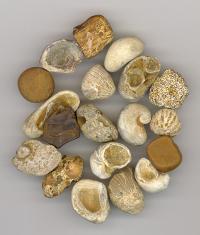 Fossils Chair, Homage to The Earth, started in January and finished today, except for refining the bark fossil patterns on the back/underside. 29 x 29 x 29 inches refurbished vintage chair, canvas strips, plaster, carved, acrylics, varnish, waxed.
Fossils Chair, Homage to The Earth, started in January and finished today, except for refining the bark fossil patterns on the back/underside. 29 x 29 x 29 inches refurbished vintage chair, canvas strips, plaster, carved, acrylics, varnish, waxed.
The back of this chair has authentic 225 – 345-million-year-old fossilized clam shells embedded around the circumference. Next, the Encyclopedia Britannica listing. The fossils were found in a mixture of playground pebbles in Dallas, TX.
The Cycad leaf fossil replica original was discovered in a Wyoming, USA river basin. Portrayed on the front of the chair is the fossil of a Cycad, the first of palm-like trees that grew about 50 million years ago in a Wyoming riverbed. The first trees on Earth were actually nothing more than woody stems standing in and absorbing nutrients from water. Patterns of fossilized Paleozoic Lepidodendron bark- leaf scars are painted on the underside of the chair. Lepidodendron were a primitive species of the very first trees on earth, reaching heights of 130 feet (40 m) tall around 400 million years ago. Can we even relate to those numbers? That’s what I love about fossils – holding one and contemplating Earth’s timeline is mind-blowing.
| Progress details: | |||||
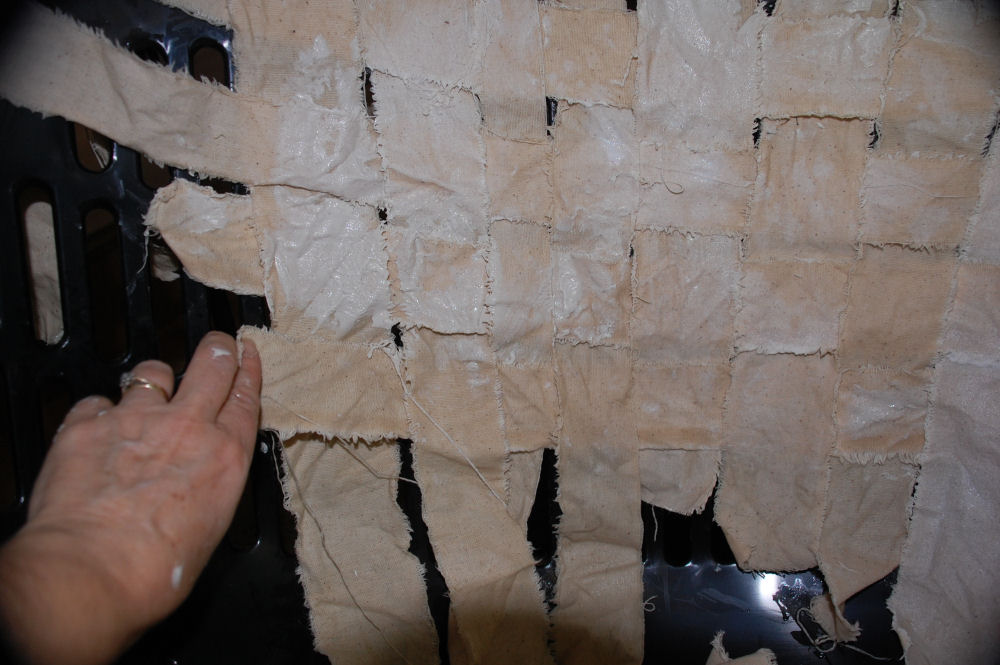 |
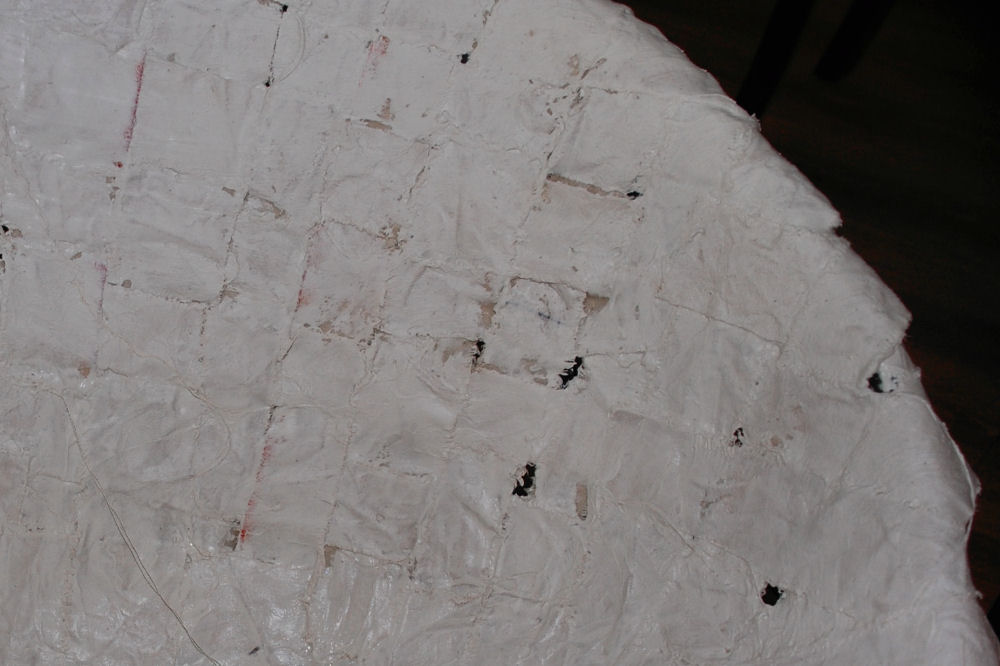 |
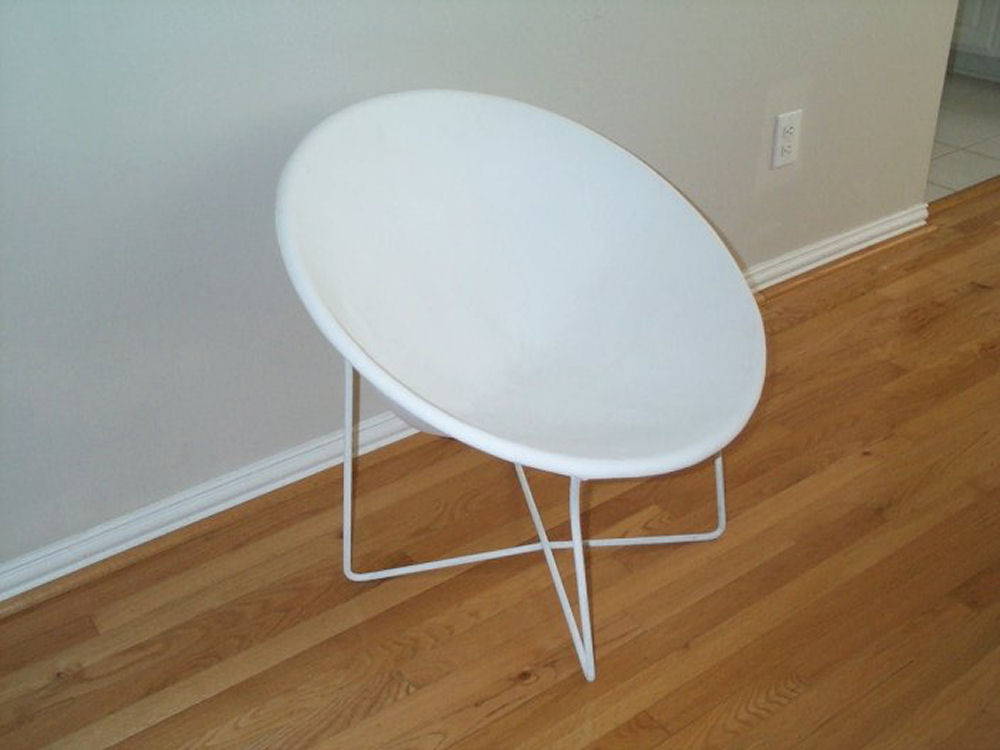 |
|||
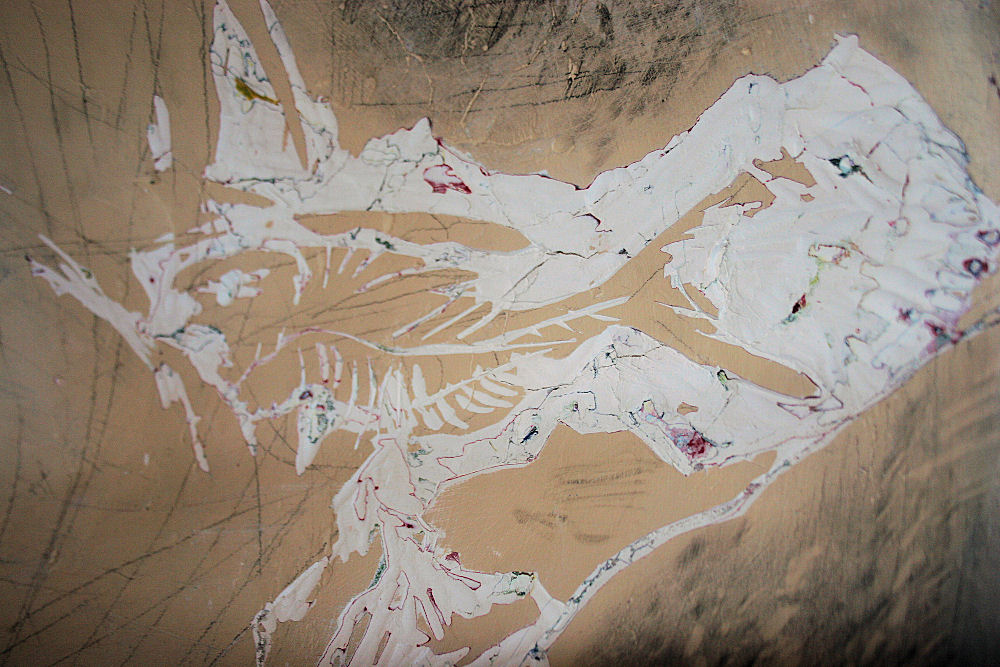 |
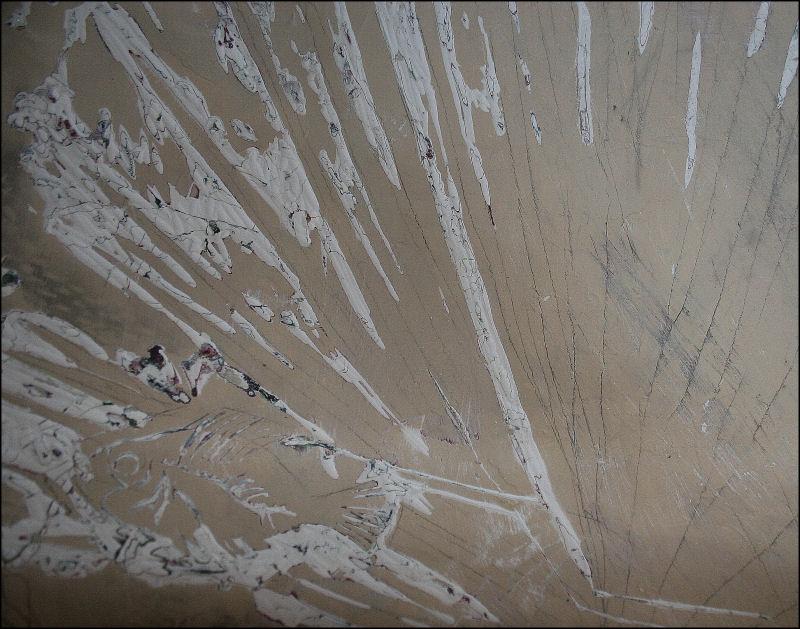 |
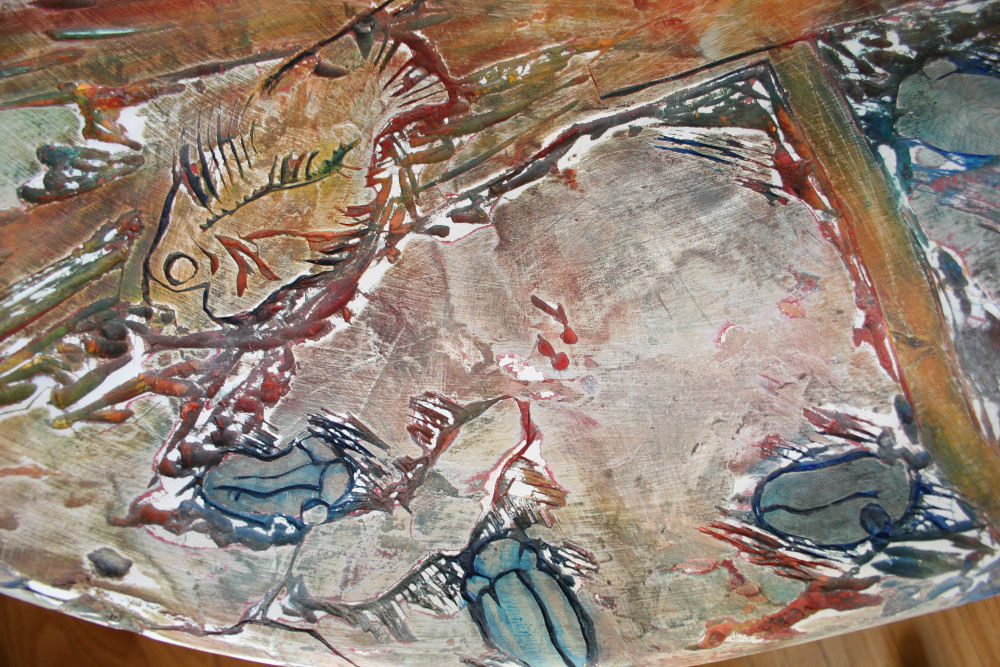 |
|||
| Finished details: | |||||
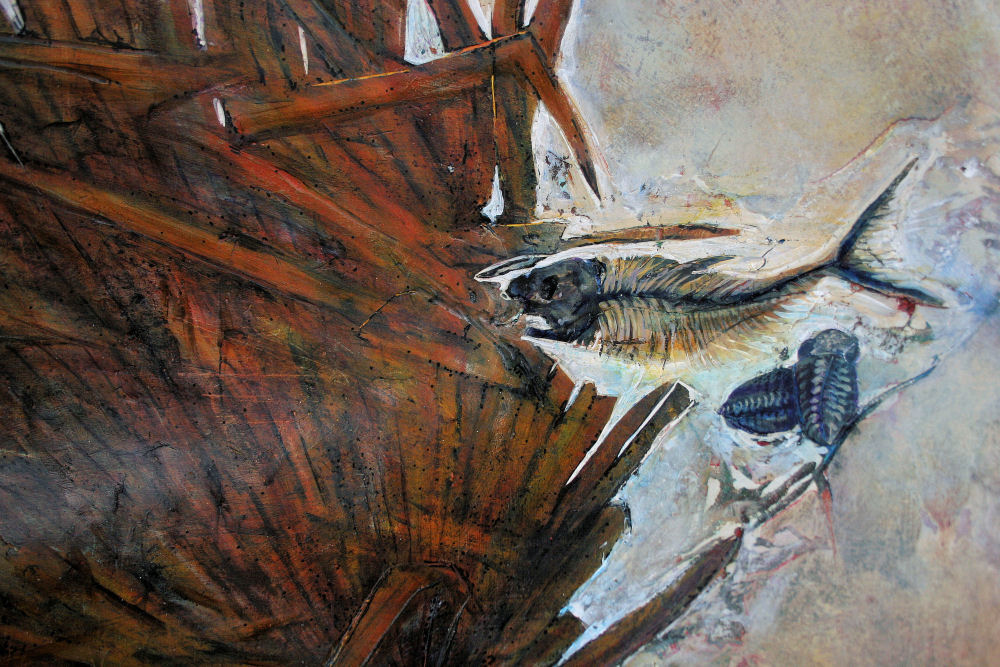 |
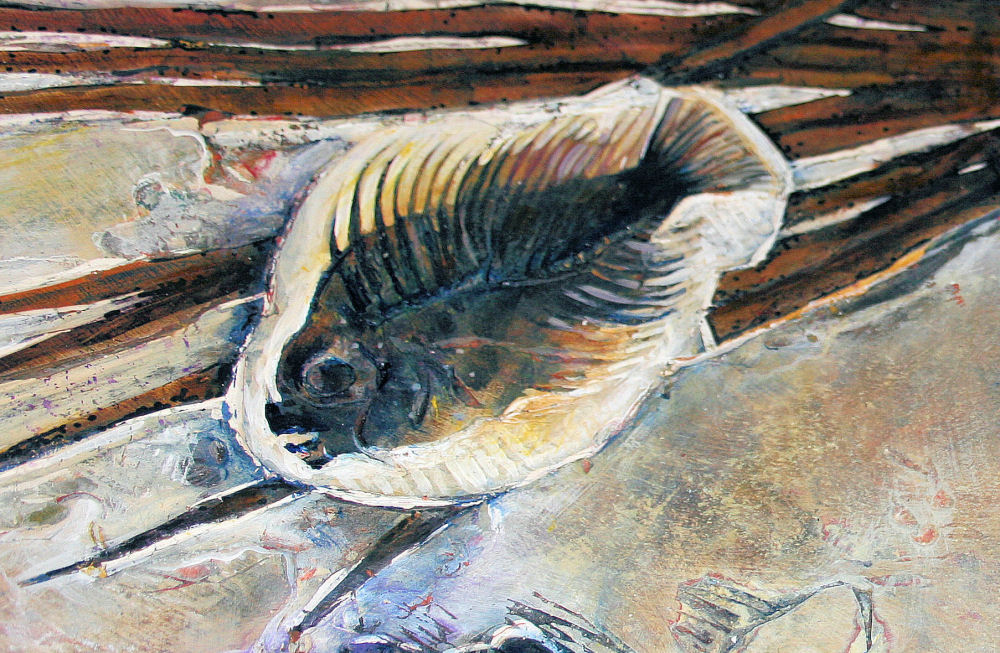 |
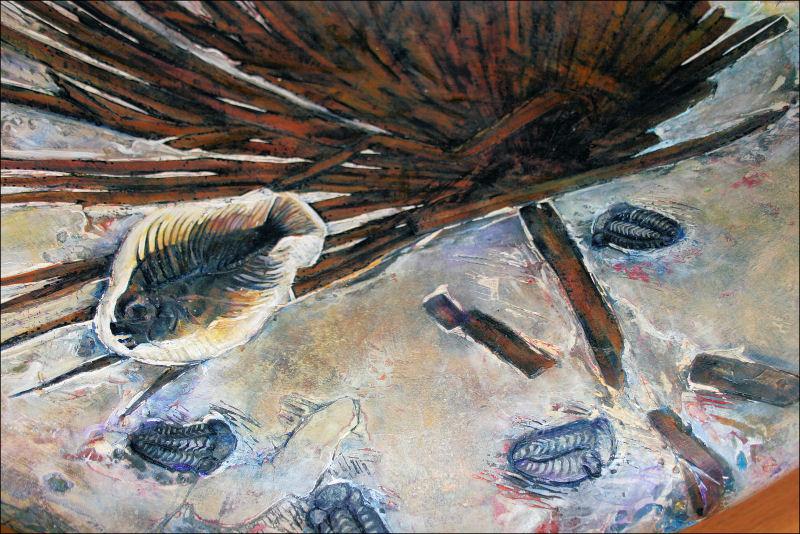 |
|||
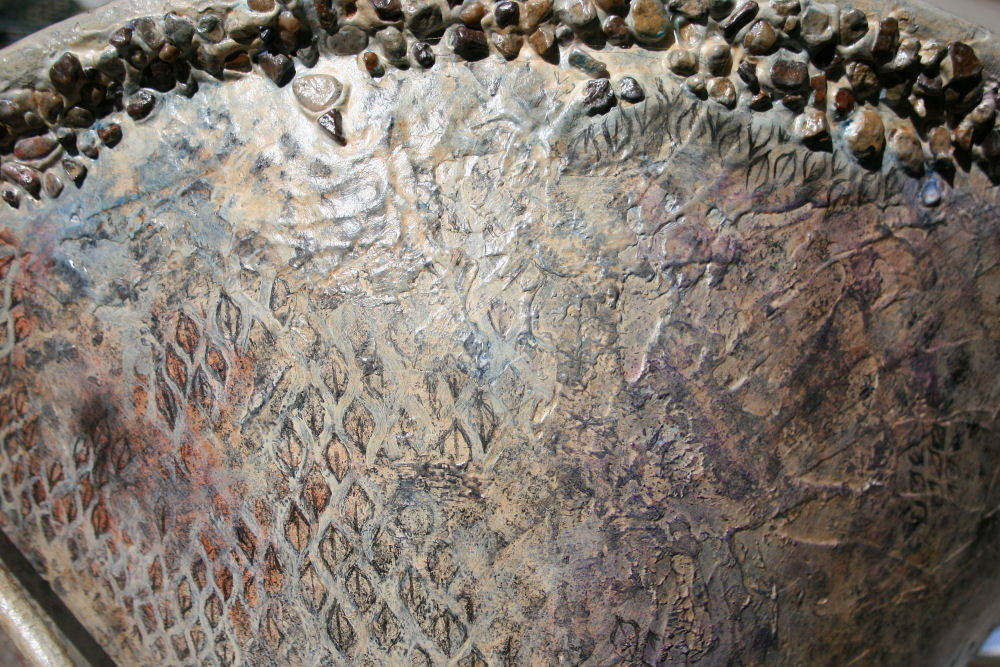 |
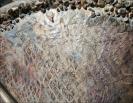 |
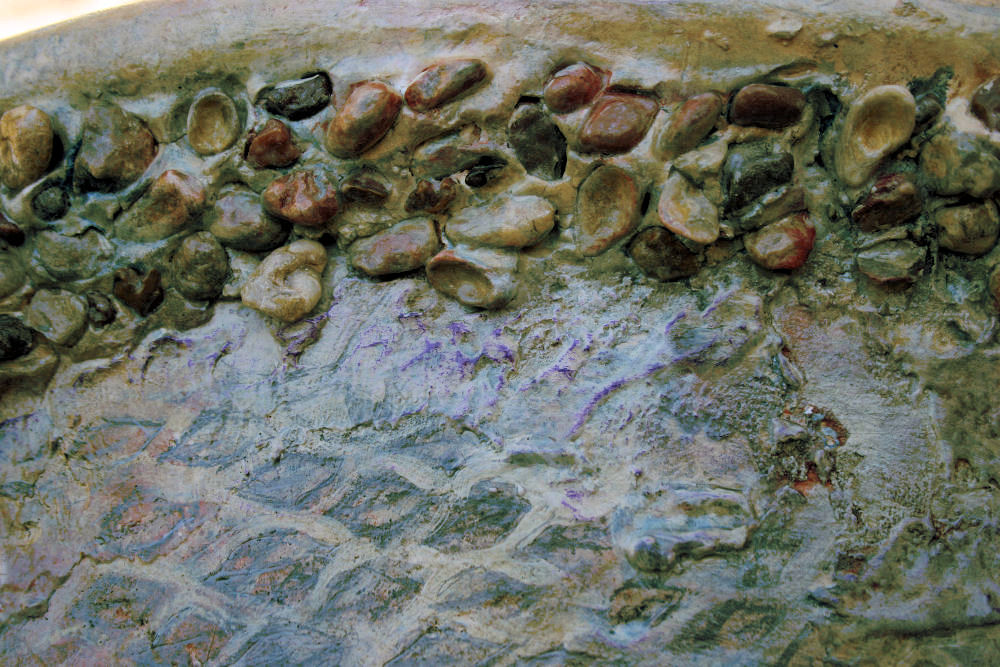 |
The Tree Of Life chair
Saturday, April 18th, 2009
April 18th, above: still in an extremely rough state, and still deciding about which colors to use and how. There must be much more plaster on the Salish chair, because this one is not carving as well. Only the Shou symbol will stand out carved..all else will be implied. Blue, purple and green are the new black! Actually that’s the old impressionist trick of course, but I also rarely use black if those 3 will do – they are much livelier and more interesting than flat black. The Yin-Yang/Aboriginal legend snakes have been eliminated because working them in color-wise was going to be a problem. The Celtic design was getting lost in too much else around it. I am anxious to find another chair because I really want to do one with Australian-inspired motifs and colors.
Post-dated note: Unfortunately, there is not enough room to show this for the premier of the Trees show in Raleigh. I’m mostly relieved that there is extra time in my schedule now for preparations, but this chair now needs to be set aside in light of the other priorities.
April 14th: 29H x 29W x 29D inches vintage chair, canvas strips, layers of sanded plaster.
The design incorporates a few esoteric concepts common to many world cultures: Overall is the idea of the Tree of Life and the theory of As above, So below, represented by branches and roots. Symbolic of longevity along with the pine tree, and central to the design is the Japanese character, Shou. The branches and roots of the pine tree are interwoven in the classic Celtic style, inspired by designs in the Book of Kells, gospel manuscripts that were illustrated by Irish monks around the year 800 A.D., common era. Two snakes drawn in the Yin-Yang placement represent Australian Aboriginal legends; the Rainbow Snake is their most important sacred symbol, believed to be the creator of all things. Christian biblical literature it is the snake who gives the apple from the Tree of Knowledge to Eve. There are more, but the rest you may like to discover yourself!
There is still plenty of intricate work to do with the roots – this’ll be fun! Drawing freehand is much better than casting the original drawing on with light and tracing it because each time it’s drawn, first with graphite, then marker, then many layers of paint, I become more familiar with the lines and the final outline will be steady and clean.
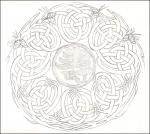 April 7, 2009: While studying some of the previous paintings that are still in progress, I sketched out my version of The Tree of Life, a preliminary drawing for the fourth refurbished vintage chair, and have also been layering and sanding the plaster in preparation for it. Colors planned are black, off-white and greens. The other chairs in this series are shown here.
April 7, 2009: While studying some of the previous paintings that are still in progress, I sketched out my version of The Tree of Life, a preliminary drawing for the fourth refurbished vintage chair, and have also been layering and sanding the plaster in preparation for it. Colors planned are black, off-white and greens. The other chairs in this series are shown here.
Salish Spindle Whorl Chair finished
Saturday, December 20th, 2008
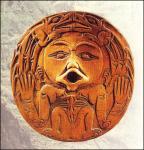 About the chairs: Art on Art on Art – A Tribute to Creativity
About the chairs: Art on Art on Art – A Tribute to Creativity
Each functional, comfortable 29 x 29 x 29 inch replica of ancient Art or artifact re-utilizes vintage plastic lawn chairs that were considered Art during the 1960’s. The original structures, damaged or unusable were refurbished by a process of weaving canvas strips along with white glue paper-mache style over the entire plastic top and bottom, and multiple layers of drywall compound sanded in between coats. Designs are drawn with graphite, painted with acrylics and a few coats of varnish for durability, then waxed to finish and enrich the colors. Two more Solaire chairs and other styles of chairs are in various stages of completion yet to be embellished with historic Art themes from other cultures. Other styles of chairs are also in progress.
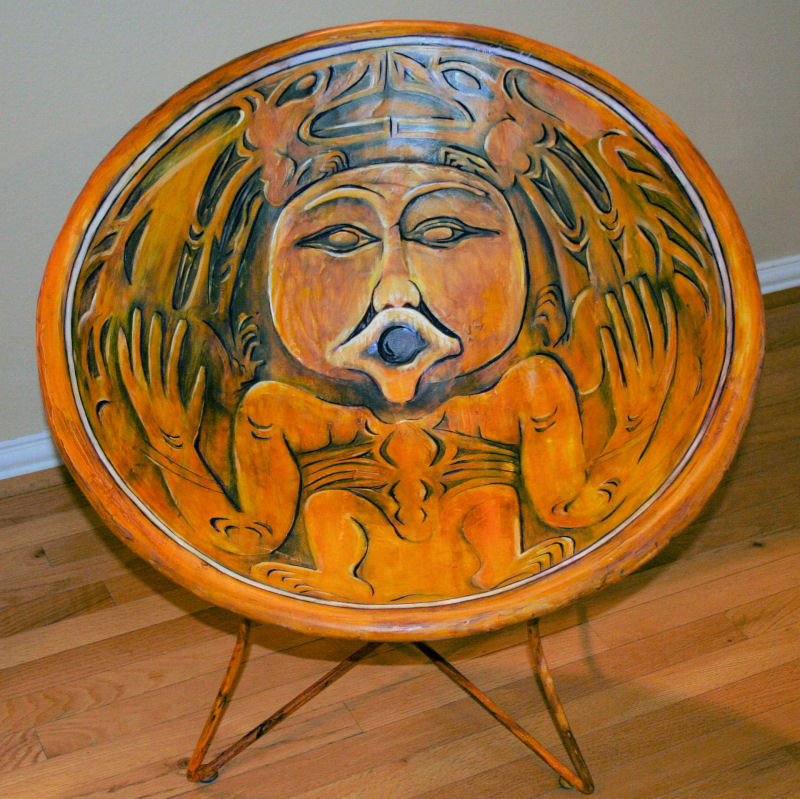 The skeletal structure of these chairs, called Solaire chairs, were manufactured during the 1960s and 1980s. Art in their own day, these particular ones were unusable; in poor condition they were bound for the landfill sight. Originals designed by Fabiano and Panzini, a French Canadian team, the Solaire chairs are now collectors items, some selling for $500.
The skeletal structure of these chairs, called Solaire chairs, were manufactured during the 1960s and 1980s. Art in their own day, these particular ones were unusable; in poor condition they were bound for the landfill sight. Originals designed by Fabiano and Panzini, a French Canadian team, the Solaire chairs are now collectors items, some selling for $500.
The first chair to be up-cycled was a large replica of a Mayan bowl. The Mayan culture (Mexico, Guatemala, Belize and parts of Honduras, 900 B.C. – 900 A.D. Common Era) developed a very complex written language using pictographs. Many of these were facial expressions and hand gestures. The bowl displays the birth of the Maize God, and along the top edge the name of the bowl’s owner is written, as well as possibly what it was used for.
Salish Carved Wood Whorl
 Whorls are weights that stabilize used for spinning yarn. The yarn in this case would have been wound just above the whorl. Spinning yarn and weaving fabric are some of humankind’s oldest technology. Left: example of a spindle with whorl, Eve Spinning Illuminated Manuscript c. 1170 A.D.
Whorls are weights that stabilize used for spinning yarn. The yarn in this case would have been wound just above the whorl. Spinning yarn and weaving fabric are some of humankind’s oldest technology. Left: example of a spindle with whorl, Eve Spinning Illuminated Manuscript c. 1170 A.D.
Historically everywhere wood has been used for tools, utensils and everyday items, they were often carved. The original spindle whorl that was the inspiration for this chair was used by a Salish Northwest Pacific coast community living south and east of Vancouver Island. Here a central human figure holds two otters. A Kwakiutl (also living in Vancouver Island territory) prayer to a Cedar tree prayer was very much a part of the inspiration for this chair. It reads: “Look at me friend! I come to ask you for your dress, since there is nothing you cannot be used for. I come to beg you for this, Long-life maker”.
December 18th: Finishing details, further definition with acrylics and two coats of varnish, waxed. Decided against the decoupage of the Kwakiutl prayer to a Cedar tree because it does not look as good as hoped. December 16th: Carved the plaster in areas then inlaying purple for contrast rather than black. Purple glazes also make yellows much richer.
The back and under-side of the chair is painted to look carved. The undercoat of yellows shines through succeeding layers, and carved wood textures are created with varnish leaving raised brushstrokes, and am trying whatever else I can think of to make it look like wood! More modeling with plaster and light sanding, then redrawing with graphite, and the design is continually adjusted.


